Green Chemistry Education in the News:
Select a Category
6 Conversations to Help You Bring Sustainable Science Into Your K-12 Classroom
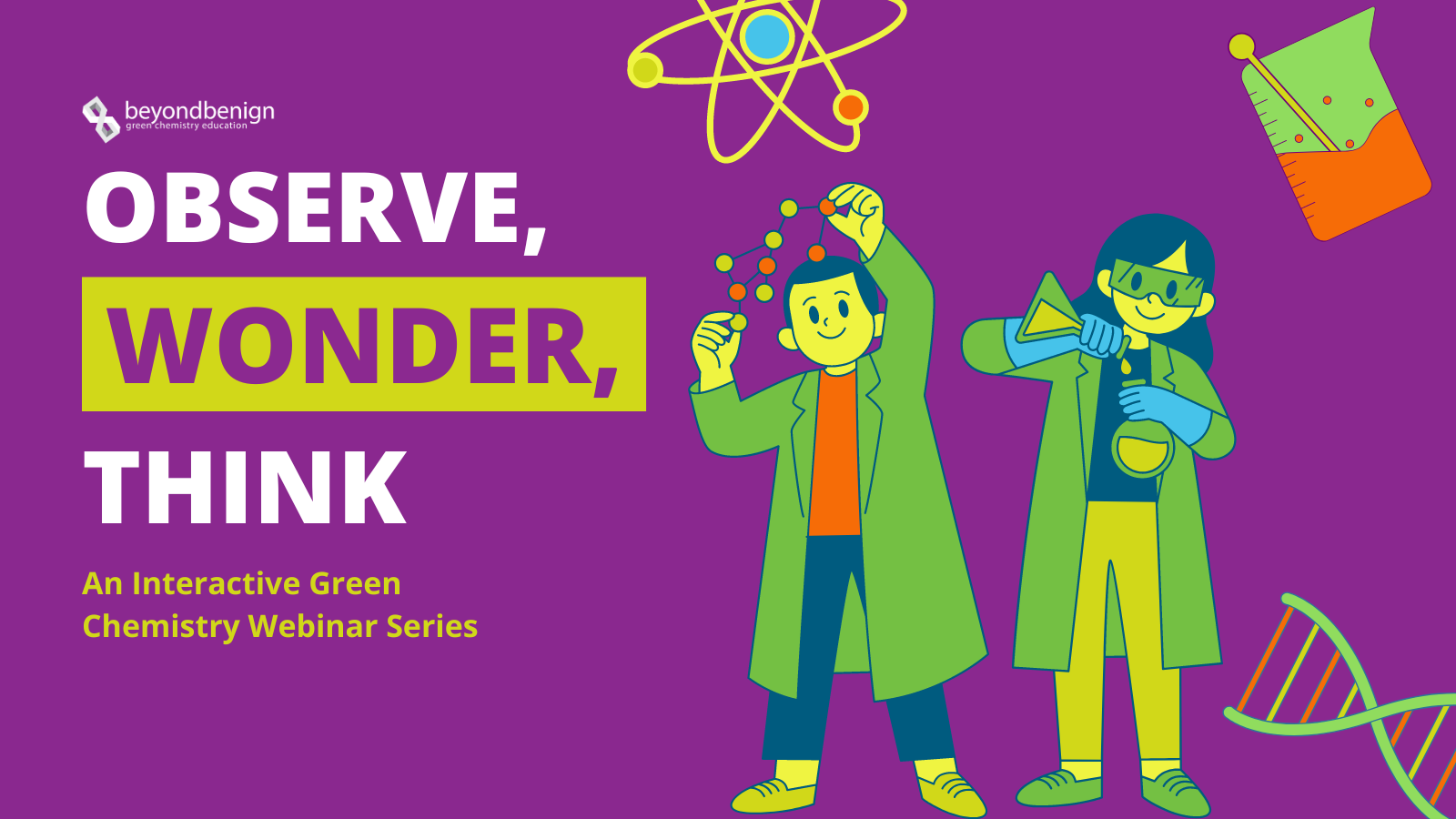 The K-12 teaching community is a powerhouse. By bringing green chemistry into primary and secondary classrooms, teachers can spark student engagement, create safer learning environments, and inspire future scientists to think sustainably. Beyond Benign’s Observe, Wonder, Think webinar series connects K-12 teachers with peer collaboration, community support, and encouragement to help them do just that.
The K-12 teaching community is a powerhouse. By bringing green chemistry into primary and secondary classrooms, teachers can spark student engagement, create safer learning environments, and inspire future scientists to think sustainably. Beyond Benign’s Observe, Wonder, Think webinar series connects K-12 teachers with peer collaboration, community support, and encouragement to help them do just that.
During our 2024-25 series, we hosted seven sessions and welcomed six speakers who shared their expertise in green chemistry teaching on topics ranging from equitable grading practices to chemical management and safety. At each gathering, participants had the opportunity to bring resources, labs, lessons, and articles they sought to implement. “Observe, Wonder, Think is a great venue for connecting with experienced educators and learning from their adventures in teaching green chemistry,” says Michelle Ernst Modera, Beyond Benign’s K-12 Community Engagement Manager. “How often do you get an opportunity to spend an hour with a teacher or safety expert who will not only offer resources and expertise, but answer your questions and offer to connect afterward?”
We are grateful to our guest speakers, the educators who joined us for these sessions, and to this season’s facilitator, Esther Hines, a retired chemistry teacher and American Chemical Society mentor. If you missed the series or want to revisit the insights shared, tune in to the recordings below. Then, explore the accompanying forum threads or resources on the Green Chemistry Teaching and Learning Community (GCTLC).
Implementing a Green Chemistry Lab With Esther Hines
Implementing a green chemistry lab is easier than you think, especially if you have support from experienced teachers in the green chemistry community of practice. In this session, Observe, Wonder, Think facilitator Esther Hines shares her experience learning how to implement green chemistry practices in labs and classrooms, and invites attendees to share their journey to practicing as well.
Safer Science Framework With Dr. Elizabeth Braun
In this session, Dr. Elizabeth Braun, Director of Educational Content and Learning at the Laboratory Safety Institute, introduces us to the Safer Science™ Program, a framework designed to empower educators with the tools they need to create hazard-free, sustainable lab environments. By addressing outdated chemicals and integrating holistic safety practices, this framework enables teachers to confidently explore green chemistry, fostering safer and greener classrooms that align with national standards, such as the Next Generation Science Standards.
Explore a curated collection, created in collaboration with the Laboratory Safety Institute, featuring curriculum materials and resources on the GCTLC that highlight safer laboratories.
Social Justice Science Issues With Nina Hike
Learn about social justice science issues in this session with Nina Hike, a leader in chemistry education and a 2021 Illinois finalist for the Presidential Award for Excellence in Math and Science Teaching. Throughout her career, Nina has integrated social justice and Next Generation Science Standards to create a more meaningful, current, and engaging curriculum in her labs and classrooms. Hear Nina’s journey from growing up in a chemically hazardous environment to becoming a biologist and chemistry teacher, and learn how green chemistry plays a vital role in addressing chemical toxicity and environmental impact.
Join the conversation in the GCTLC forums and read more insights from Nina in her “Ask Me Anything” interview.
Equitable Grading Practices With Raksmey Derival
Hear from Raksmey Derival, a high school science teacher, science ambassador, and program director at Innovation Academy Charter School. In this session, Raksmey called educators in to explore how grading for equity supports student growth and accurately reflects student ability. Raksmey encouraged participants to observe the purpose of grading for equity, wonder what quiz assessments and grading rubrics might look like using different methods, and think about guiding students “beyond the beaker.”
Join the conversation in the GCTLC forums.
Chemical Management & Lab Safety With Sarah Briggs
Sarah Briggs, Senior Research Specialist in Green Chemistry and Emerging Contaminants at the New York State Pollution Prevention Institute, shares her expertise in chemical management and disposal. She delves into essential topics, including common safety concerns related to chemical storage and disposal, effective chemical inventory management strategies, and best practices for working in shared stockrooms. Additionally, she explores how the principles of green chemistry can be used to address these challenges, providing practical solutions for safer and more sustainable lab environments.
Join the conversation in the GCTLC forums.
Toxicology With Annette Sebuyira
In this session, experienced educator Annette Sebuyira shares an introduction to green chemistry through the lens of toxicology. Together, we delve into a lesson that aligns with the Next Generation Science Standards and New York State Science Learning Standards, expanding content knowledge and the skills necessary to provide developmentally appropriate instructional strategies and assess student progress. We explore challenges (as students would!) using the Olin Chemical Superfund Site as a case study, and employ a toxicology lens to inform decisions on how and why certain reagents are selected for our lab performances.
Join the conversation in the GCTLC forums.
How to get involved:
- Access free resources and curricula on the Green Chemistry Teaching and Learning Community, including our Sustainable STEM Unit for middle school students and Plate to Planet Curriculum for elementary school students.
- Explore the guidebook “GREEN CHEMISTRY AND SUSTAINABLE SCIENCE: A Green Approach to Sustainable STEM in K-12” to learn how to implement green chemistry in your K-12 classrooms and labs.
- Connect with your peers in the Green Chemistry Teaching and Learning Community forums. There are dedicated threads for K-8 and high school educators.
- Subscribe to Beyond Benign’s newsletter to receive green chemistry resources, inspiration, and opportunities directly in your inbox.
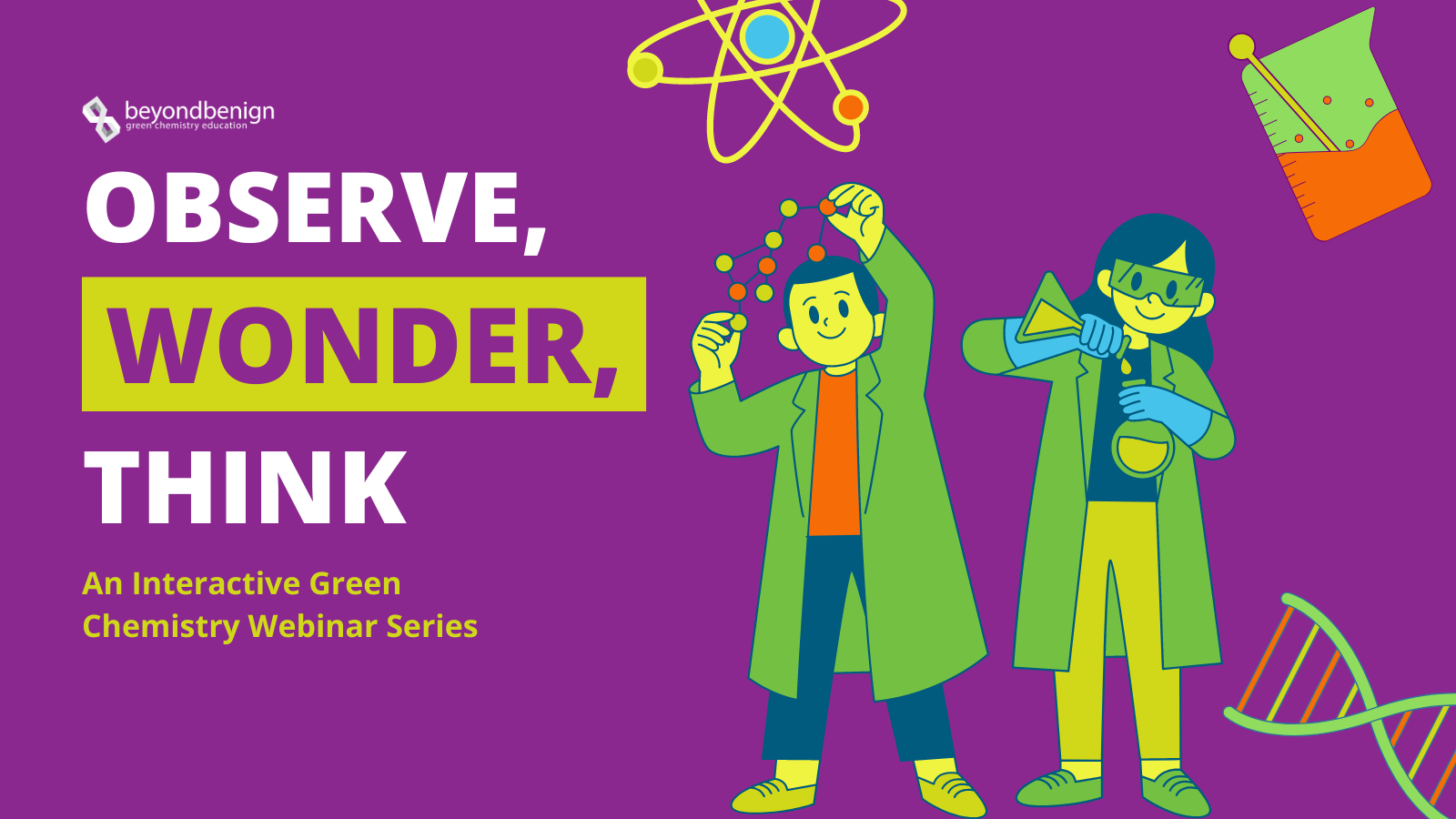
6 Conversations to Help You Bring Sustainable Science Into Your K-12 Classroom
July 22, 2025
The K-12 teaching community is a powerhouse. By bringing green chemistry into primary and secondary classrooms, teachers can spark student engagement, create safer learning environments, and inspire future scientists to […]
Categories:
From Our Community: How Student Leadership Helped Bring the Green Chemistry Commitment to Queen’s University
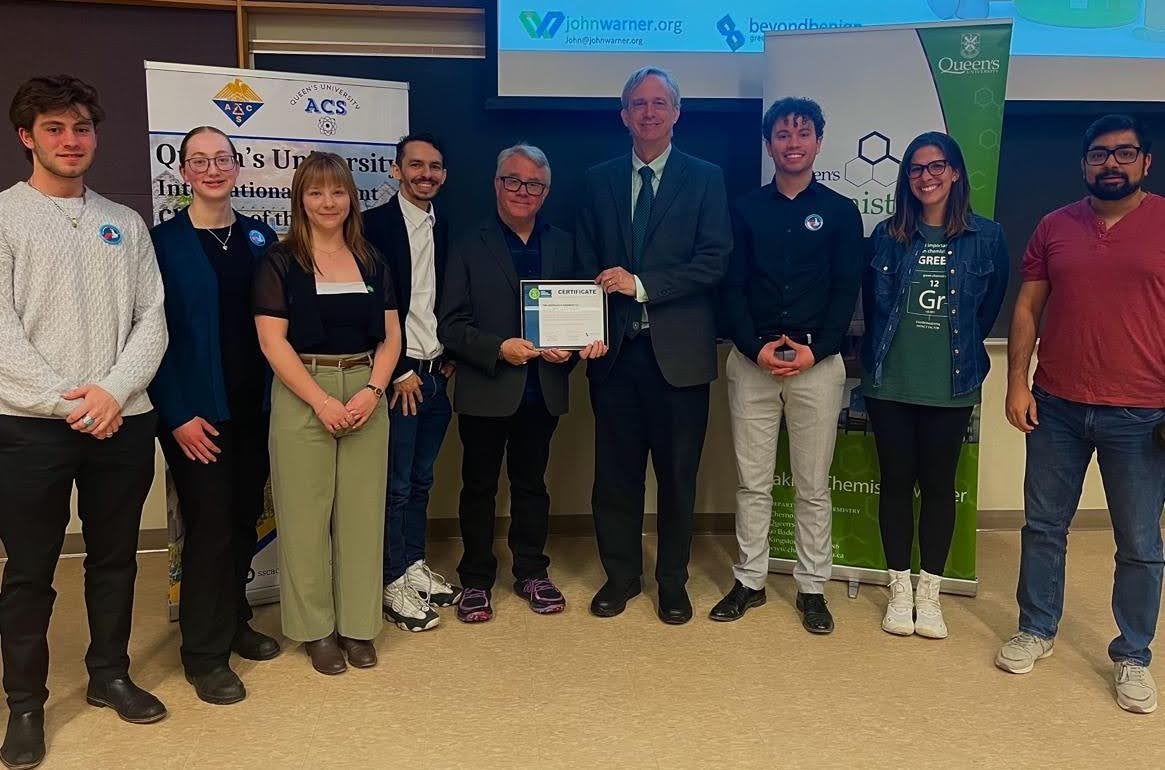
Student and community leaders gathered for a Green Chemistry Commitment signing celebration at Queen’s University in Kingston, Ontario. Pictured from left to right: Tyler Rotholz (Q-ACS), Rachel Wood (Q-ACS), Rachel Korchinsky (Q-ACS), Giovanni Brito (Q-ACS), Dr. John Warner (Beyond Benign), Dr. Philip Jessop (Queen’s University), Max van Zyl (Q-ACS), Dr. Juliana Vidal (Beyond Benign), and Dr. Hriday Bhattacharjee (Q-ACS).
Beyond Benign was thrilled to welcome Queen’s University in Ontario, Canada, to the growing Green Chemistry Commitment (GCC) program in 2024. The GCC is a framework created to expand and unite the global higher education community practicing green chemistry. Students, both at the graduate and undergraduate levels, play an integral role in advancing green chemistry and helping to bring the GCC to their campuses. The article below, contributed by Rachel Korchinsky and GCC Community Ambassador Giovanni Brito, is an excellent example of student leadership. Read the article to learn how the Queen’s University International Student Chapter of the American Chemical Society is advancing green chemistry through the GCC and other initiatives.
Contributed by Rachel S. Korchinsky and José Giovanni L. Brito
The Queen’s University International Student Chapter of the American Chemical Society (Q-ACS) hosted a special ceremony in Chernoff Hall on May 6, 2025, to celebrate a significant milestone: the Queen’s Department of Chemistry has officially become a signer of the Beyond Benign Green Chemistry Commitment (GCC). Q-ACS played a pivotal role in this achievement.
Recognized as an Outstanding Student Chapter for two consecutive years (2022-2023 and 2023-2024) and the 2024-2025 Alma Mater Society Club of the Year, Q-ACS strives for excellence across its activities, events, and outreach. Q-ACS is deeply committed to advancing professional and technical development while promoting inclusion and belonging within the Queen’s chemical community. By supporting the Department of Chemistry in becoming a GCC signer, Q-ACS has played a pivotal role in raising awareness of green chemistry, an effort that will benefit students and the chemical community at large, whether they pursue careers in academia or industry. Motivated by a strong commitment to sustainability, many members of Q-ACS align their research with the United Nations’ Sustainability Goals, emphasizing the importance of green chemistry as a pathway to a more sustainable and equitable world.
“Signing the Green Chemistry Commitment marks a meaningful milestone in advancing green chemistry education at Queen’s University,” says Rachel Korchinsky, Ph.D. ’26, Vice President of Q-ACS. “It is essential that future generations of chemists approach their work through a green chemistry lens, which was emphasized throughout Dr. Warner’s inspiring seminar. Through the collaboration and support of many, especially Dr. Philip Jessop and the team at Beyond Benign, this achievement was made possible.”
The highlight of the GCC signing ceremony was a keynote address by Beyond Benign Co-Founder Dr. John Warner, who is a co-founder of the green chemistry movement and the CEO & CTO of Technology Greenhouse. Introduced by Jessop, Canada Research Chair in Green Chemistry and Chemistry Department Head at Queen’s University, Warner delivered the inspiring talk, “Green Chemistry as the Foundation of Sustainability and the Circular Economy.” His address emphasized that while much attention is paid to why sustainability matters and what frameworks exist to measure it, green chemistry addresses the critical how. By integrating sustainability into the earliest stages of research and development, scientists can ensure that their work has a lasting, positive impact. Warner concluded the ceremony by formally presenting the GCC certificate, symbolizing Queen’s University’s official recognition as a leader in sustainable chemical education, followed by a complimentary networking lunch hosted by Q-ACS.
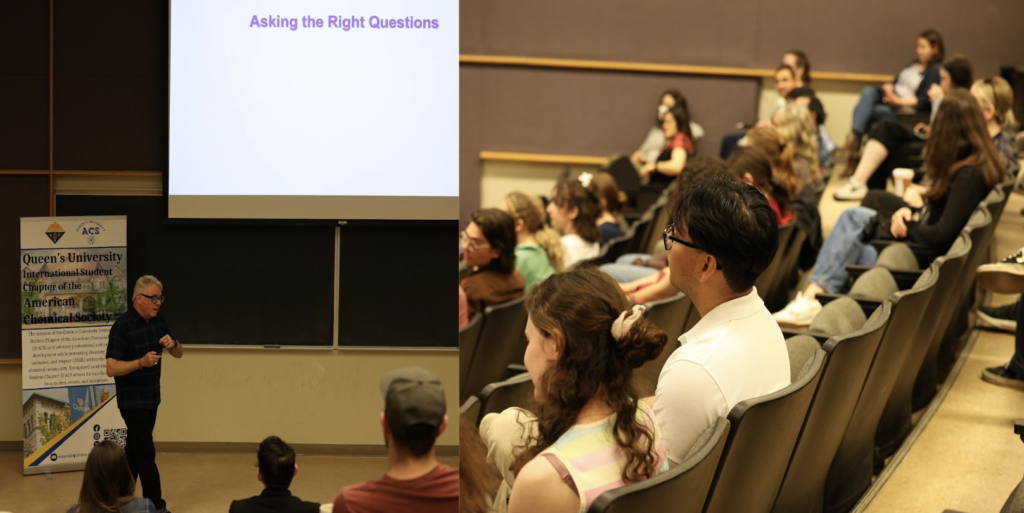
Dr. John Warner (left) delivered the talk “Green Chemistry as the Foundation of Sustainability and the Circular Economy” during the Queen’s University Green Chemistry Commitment Signing Ceremony.
“Being a Green Chemistry Commitment Ambassador myself and also a graduate student doing research on Green Chemistry, seeing Dr. Warner in person in our Department of Chemistry hit me in a substantial and meaningful way,” says Giovanni Brito, PhD ’25, Q-ACS Treasurer. “He is one of the most reputable and respected researchers in the field, so I felt really grateful to learn directly from him and to witness attentively his passion and vision. In addition to this, we at Q-ACS could not thank enough the wonderful and unwavering support coming from Beyond Benign. Dr. Juliana Vidal in particular played a vital role in helping us coordinate Dr. Warner’s visit, for which our Chapter is indebted.”
Q-ACS continues to advocate for green chemistry through active outreach efforts and collaboration. The Chapter has partnered with the Green Chemistry Initiative at the University of Toronto and Green Chemistry McGill to collaborate on the 2025 Green Chemistry Initiative Symposium, themed “Thinking Green(er) in Daily Life,” which was hosted at the University of Toronto from May 7-9, 2025. Dr. Hriday Bhattacharjee, the Professional Development Director of Q-ACS, says, “We diligently work to integrate and provide opportunities to the chemical community at Queen’s through various events throughout the year.”
Additionally, Q-ACS will be facilitating the “Which Is Greener?” series in collaboration with Jessop. This series is designed to educate the public on the sustainability of consumer products and to answer the question: Which is greener? “It’s just one part of Q-ACS’s outreach efforts, but it is a meaningful way to engage with the community and encourage greener thinking in everyday decisions,” says Rachel Wood, MSc ’25, Q-ACS Public Outreach Director.
In recognition of its ongoing efforts, Q-ACS has been invited by the Chemical Institute of Canada’s Green Division to be featured for its green chemistry initiatives at the Canadian Society for Chemistry 2025 conference. The Chapter will be highlighted in the workshop, “Bring Green Chemistry into Your Lab: A Workshop for Graduate Students and Postdoctoral Fellows.” Tyler Rotholz, CHEM-P-BSH ’26, the Undergraduate Affiliate of Q-ACS, says, “It’s very exciting to be a part of Q-ACS, as every member is dedicated to exemplifying a standard of excellence; I feel fortunate to contribute to events and initiatives like these.”
Through these initiatives and many more to come, Q-ACS ensures that green chemistry at Queen’s University is highlighted, constantly shedding light on and educating others about the importance of making a sustainable future for all.
How to get involved:
- Keep up with Q-ACS on social media! Follow the chapter on Instagram, Facebook, X, and LinkedIn.
- Not yet part of the Green Chemistry Commitment (GCC)? Learn how your institution can become a signer and provide students with essential skills and training for today’s workforce.
- Subscribe to Beyond Benign’s newsletter for the latest updates from the green chemistry community.

From Our Community: How Student Leadership Helped Bring the Green Chemistry Commitment to Queen’s University
July 15, 2025
Beyond Benign was thrilled to welcome Queen’s University in Ontario, Canada, to the growing Green Chemistry Commitment (GCC) program in 2024. The GCC is a framework created to expand and […]
Categories:
Reflection: My first GCC Summit and ACS Green Chemistry and Engineering Conference
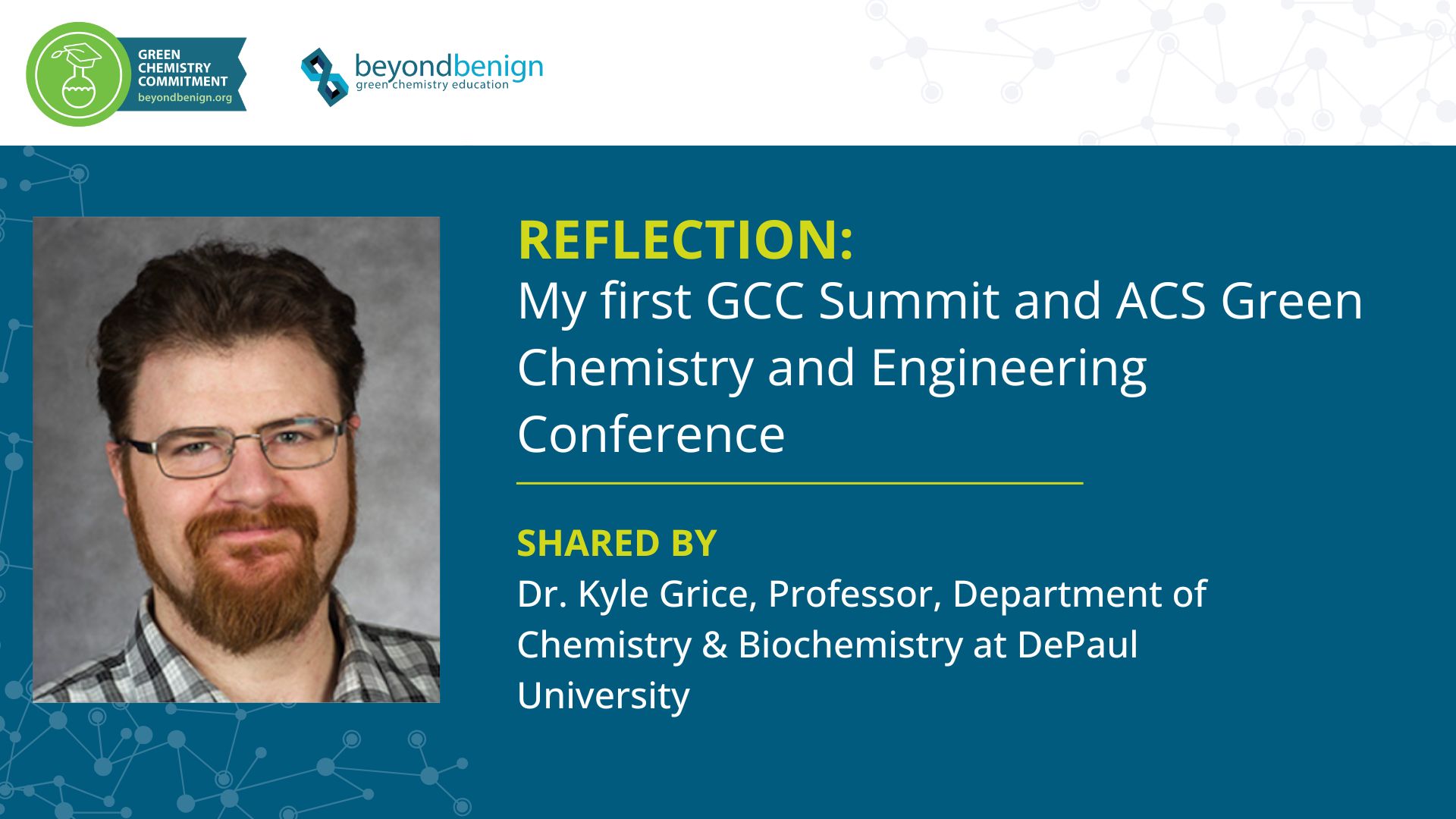 Dr. Kyle Grice is a Professor in the Department of Chemistry and Biochemistry at DePaul University in Chicago, Illinois. He
Dr. Kyle Grice is a Professor in the Department of Chemistry and Biochemistry at DePaul University in Chicago, Illinois. He
Interested in sharing an article or reflection for publication on the Beyond Benign website? Email Cloë Di Flumeri at cloe_diflumeri@beyondbenign for more information.
Read more about green chemistry at DePaul University, here.
My brain is still buzzing with ideas from the ACS Green Chemistry and Engineering (GC&E) conference last week, and the afterglow is still going strong. It was my first time going to this conference, but it certainly won’t be my last. It was the kind of uplifting and invigorating conference experience that I hadn’t had in a while, and definitely needed.
I wanted to share my experience so folks who haven’t been to an ACS GC&E conference (like me before I went this year) might know what it’s like. Over the last several years I’ve been getting more into the field of Green Chemistry in both teaching and research. I’ve been researching CO2 reduction since my Postdoc, which is certainly related to green chemistry, but only in the last several years I’ve been doing more deliberate work with microwave chemistry, ball milling, and other approaches to minimize solvent use, hazardous chemicals, energy, time, and waste.
A couple of years ago, I got my university to join the Beyond Benign Green Chemistry Commitment (GCC). The GCC helps with support and accountability for making your chemistry more green at your institution. We are also working on making our labs more Green in multiple ways, and have phased out dichloromethane (DCM) use.
I’ve also enjoyed chatting with folks about Green Chemistry on the Green Chemistry Teaching and Learning Community (GCTLC) forums. In addition, I recently co-authored a commentary on replacing DCM in teaching labs with Dr. Dave Vosburg from Harvey Mudd (Dave will show up later in this post).
I usually go to one conference a fiscal year, and had already gone to the ACS National Meeting in August 2024, so wasn’t planning on going to another conference in the 2024-2025 academic/fiscal year, but then I was invited to give a talk about mechanochemistry at the ACS GC&E. I was excited to share our forays into mechanochemistry, so decided to jump at the chance and go to the ACS GC&E. In addition, an in-person GCC summit was to be held before the GC&E (they also have a virtual one), and so I planned to attend that as well.
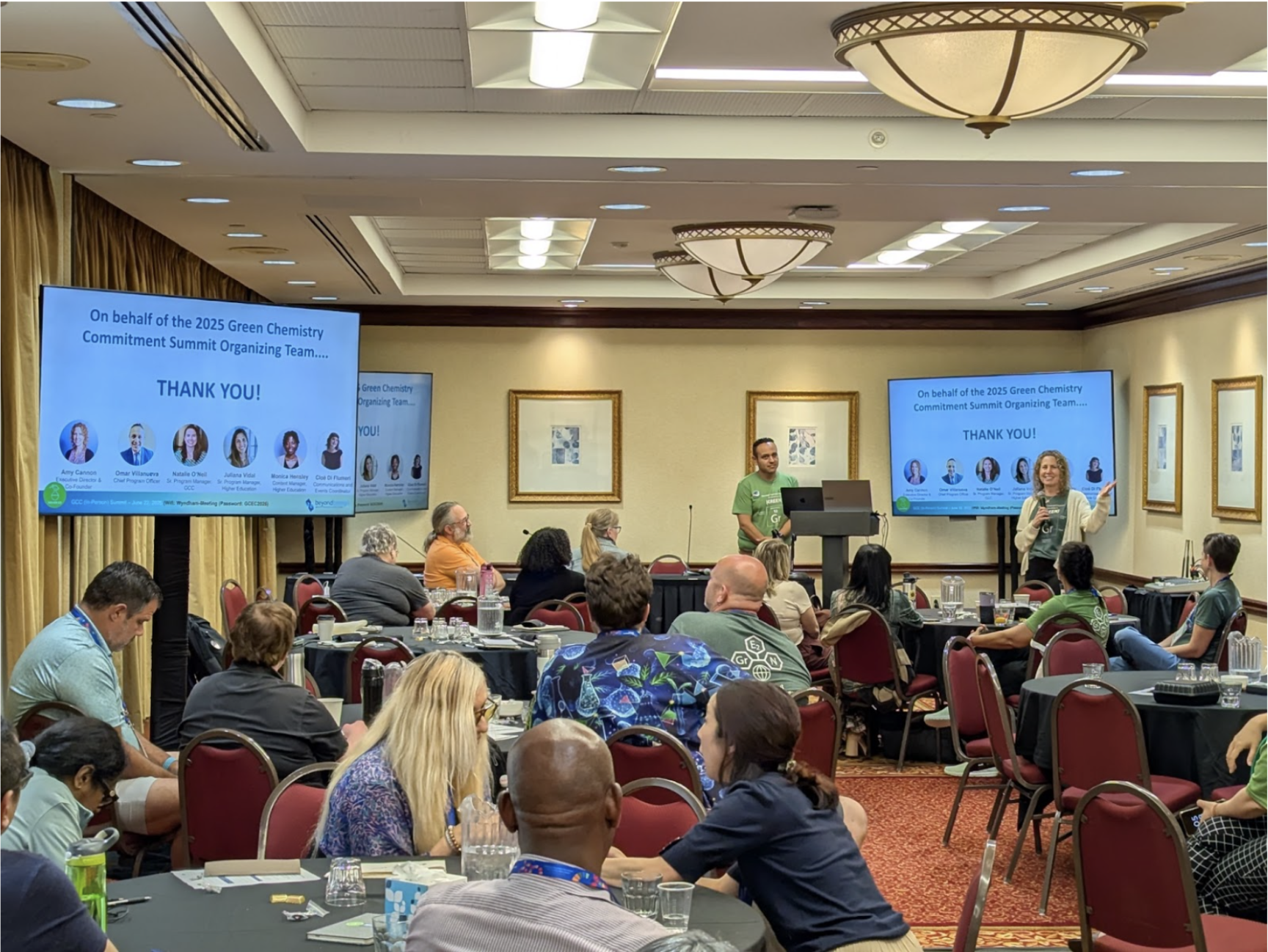
This year’s ACS GCE was the 29th year, and was in Pittsburgh, PA, which was a short flight from Chicago. The GCC and GC&E events were fully contained in one hotel, which was nice, given the heat wave happening outside. I arrived on Sunday, right at the start of the GCC Summit. During the Summit, we heard from several GCC signers about their various activities at their institutions, including the development of greener labs, the incorporation of systems thinking and green chemistry into lecture, and the development and use of a Green Chemistry-infused GOB book (keep your eyes out in the future for the book!). We also had several small group breakout sessions and discussions that were very useful. It was great to chat with faculty, staff, students, and members of Green chemistry NGOs about all of the things they were doing, and made me very excited for the GC&E. On a more somber note, they also had a celebration of Ed Brush’s life at the GCC Summit and the GC&E, and while I didn’t know him, he clearly made a huge impact on the Green Chemistry Community.
Monday was a workshop day, and there were several different workshops folks could sign up for. I hadn’t signed up for workshops, so used the day to visit friends and collaborators at the Universities in Pittsburgh. Monday evening was the opening Awards dinner ceremony. It was fantastic to hear about all the awardees, including pharmaceutical companies making their processes more Green, young researchers starting their careers in Green Chemistry, and faculty who had made an impact in the classroom. Dave Vosburg was the awardee for the Teaching Green Fellowship, and gave a very short presentation. He’s published several Green organic labs in J. Chem. Educ., and I highly recommend you check them out! His publications are here. It was also the 20th anniversary of the ACS Green Chemistry Institute’s Pharmaceutical Roundtable (GCIPR), and hearing the talks from GCIPR members was a real joy. It was awesome to see the hard work that the pharmaceutical companies were putting in to make their processes and their whole operation more Green and sustainable. The GCIPR does a lot of different things, including giving out grants to make pharmaceutical research and processes more Green.
Tuesday was the start of the conference oral symposia, kicking off with a Keynote from Louise Proud,Vice President, Global Environment, Health & Safety at Pfizer. The great thing about the GC&E was that it was small and manageable compared to huge conferences like ACS National meetings, but not too small. There were 5-6 concurrent sessions, and it was easy to hop from one to another if there were talks in different rooms that you wanted to see. At ACS National, sometimes it takes 20+ minutes just to go from one talk to another, which might be at the far end of the convention center or even out at a hotel away from the convention center. I enjoyed the chemical education talks, as well as the “Green Chemistry solutions for EHS problems” talks. I also popped into the Expo and talked to the vendors. In the evening there was a poster session, with an international group of students and researchers presenting their work.
Wednesday was another full day of talks, and I mostly stayed in the all-day mechanochemistry symposium, where I gave a talk in the morning. Speakers were from all sorts of places, including industry, primarily undergraduate institutions, and PhD-granting institutions, and did mechanochemistry with everything from a mortar and pestle, to ball mills, to twin screw extruders. On Wed I also caught a great talk by John Warner, one of the founders of Green Chemistry and Beyond Benign, as well as the author of the foundational textbook Green Chemistry, Theory and Practice. If you get a chance to hear John give a talk, I highly recommend it! I also met Paul Anastas, the other author of that text and Green Chemistry trailblazer, and both John and Paul are great people.
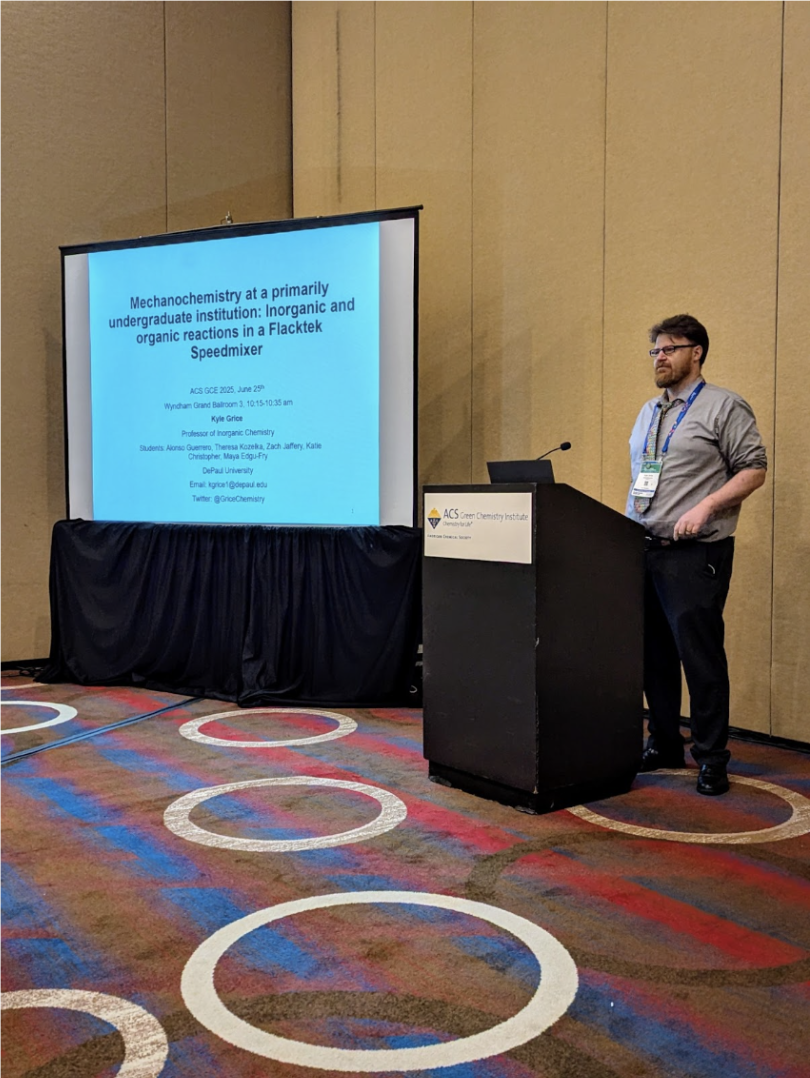
I wish I could have stayed for Thursday, but had to get back home for various reasons. What really stood out to me at the conference was how wonderful it was to be around all the great folks there. I met so many people with great ideas and projects, including some potential new collaborators. Everyone was interested in advancing sustainability and green chemistry in teaching, research, industry, and beyond. It was truly uplifting to be in a place where everyone recognized and valued the importance of Green Chemistry and sustainability. It felt so wonderful to know everyone there was trying to make things better for humans and the environment. I want to thank all of the organizers and everyone who attended for making it a great experience, and I will definitely be back and look forward to sharing more of my own Green Chemistry Teaching and Research! Until then, see you on the GCTLC forums!
Sincerely,
Kyle Grice
Professor of Inorganic Chemistry
DePaul University

Reflection: My first GCC Summit and ACS Green Chemistry and Engineering Conference
July 10, 2025
Dr. Kyle Grice is a Professor in the Department of Chemistry and Biochemistry at DePaul University in Chicago, Illinois. He teaches general chemistry, inorganic chemistry, organic chemistry, and special topics […]
Categories:
Empowering Future Scientists: Green Chemistry Education Awards Connect Students With Sustainability Skills
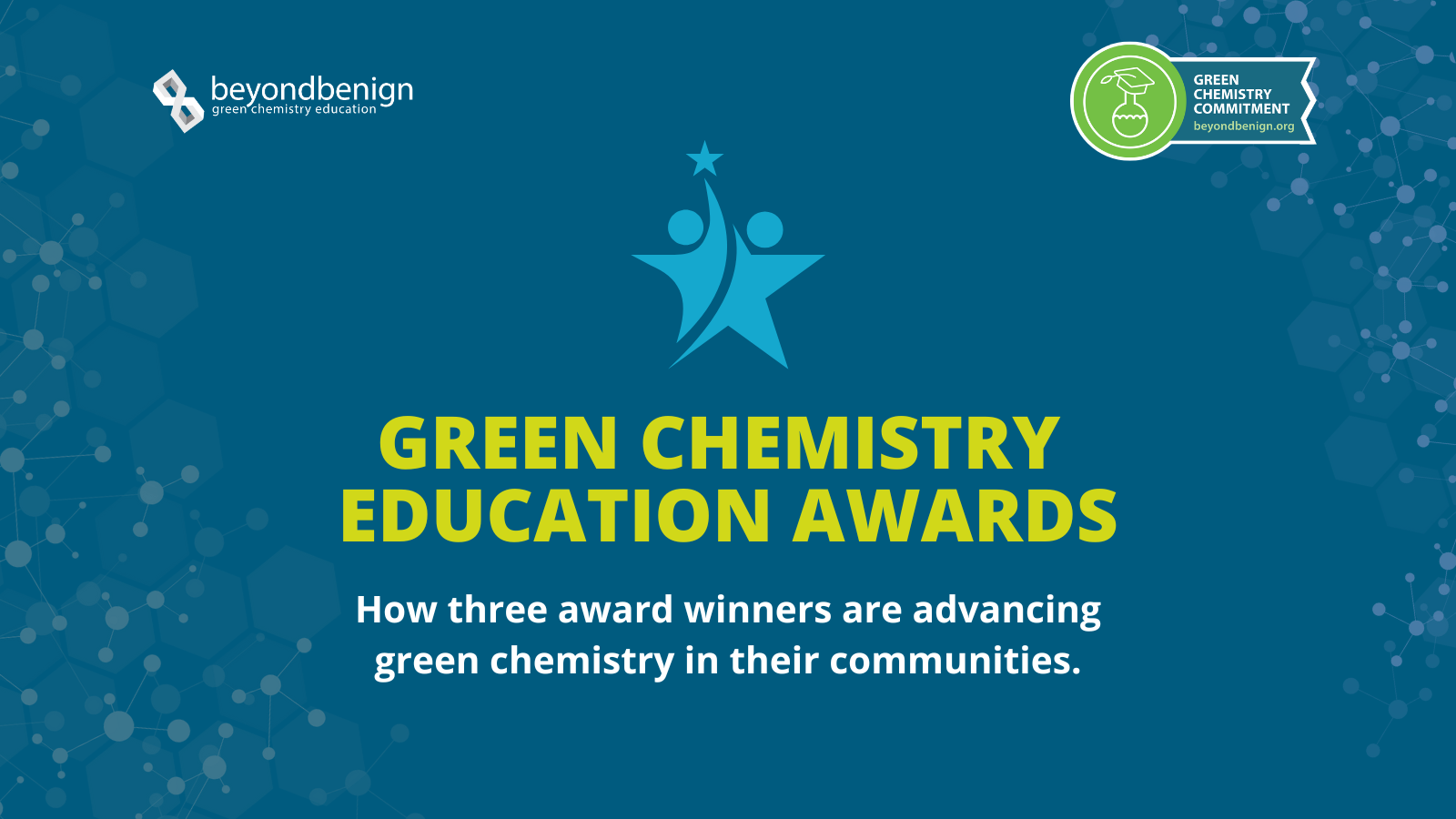 As the community of educators and institutions integrating green chemistry grows, more students are learning a sustainable approach to science. These students represent the next generation of innovators, environmental stewards, and scientists who will use their green chemistry skills and lived experiences to address local and global sustainability challenges.
As the community of educators and institutions integrating green chemistry grows, more students are learning a sustainable approach to science. These students represent the next generation of innovators, environmental stewards, and scientists who will use their green chemistry skills and lived experiences to address local and global sustainability challenges.
Beyond Benign provides educators with the tools, training, and support needed to integrate green chemistry in their classrooms and labs. As part of this mission, Beyond Benign and partners developed the Green Chemistry Education Awards for K-12 and higher education. The awards for higher education provide funding and guidance for educators at Green Chemistry Commitment (GCC) signer institutions as they embark on projects such as curriculum redesign, outreach activities, collaborations, and awareness initiatives.
Three of the 2023-2024 recipients are GCC Signer Minority Serving Institutions, which are bringing green chemistry to diverse student populations. By expanding green chemistry use on these three campuses, the awards give more students an opportunity to develop critical thinking skills and deepen their awareness of sustainable practices—tools they can carry into their professional work.
Three educators leading these initiatives recently shared updates on how they are expanding the use of green chemistry principles to help prepare the next generation of world-class chemists with skills to create innovative environmental solutions. Get an overview of the initiatives and links to a deeper dive on each below:
At California State University, San Marcos, Associate Professor Dr. Robert G. Iafe is coordinating the university’s efforts to develop a green chemistry minor by adding courses, assessment strategies, and public awareness seminars. He says the green chemistry initiative has helped students develop a new sense of purpose and enthusiasm. “Many of our students come from communities that are disproportionately impacted by environmental issues, so when they see chemistry as a means of creating safer materials, cleaner technologies, and more equitable systems, it becomes more than just a course—it becomes personally meaningful and empowering,” he says.
At Pontifical Catholic University of Puerto Rico, Dr. Adalgisa Batista Parra, Professor of Chemistry and Organic Chemistry Researcher, is leading efforts to redesign the undergraduate organic chemistry laboratory curriculum. This includes incorporating green chemistry principles with the goal of aligning instruction with emerging trends in sustainable chemistry education while actively reducing environmental impact. She says green chemistry sparked meaningful discussions among students about their role in shaping a more sustainable future. “This project is about more than just redesigning lab experiments—it’s about planting the seeds of a cultural shift toward sustainability in science education and beyond.”
At Stella and Charles Guttman Community College, Associate Professor of Chemistry Dr. Jihyun (Ji) Kim is redesigning a classic organic chemistry experiment—the synthesis of cyclohexene—to emphasize green chemistry principles and provide a safer, more sustainable laboratory experience for students at the two-year college. She says the green chemistry concepts help students see how chemistry can be a tool for environmental responsibility. “One of the most encouraging outcomes of this project was the level of student engagement with green chemistry concepts, particularly as they connected sustainability to real-world issues,” Ji says.
Learn more about the Green Chemistry Education Awards and see a full list of 2023-2024 award recipients.
How to get involved:
- Higher education leaders: Join the Green Chemistry Commitment to provide students with essential skills and training for today’s workforce.
- Connect with your peers in the Green Chemistry Teaching and Learning Community, an online space for everyone in the green chemistry community to learn, share, connect, and grow.
- Subscribe to Beyond Benign’s newsletter to get green chemistry news, opportunities, and resources delivered to your inbox monthly.
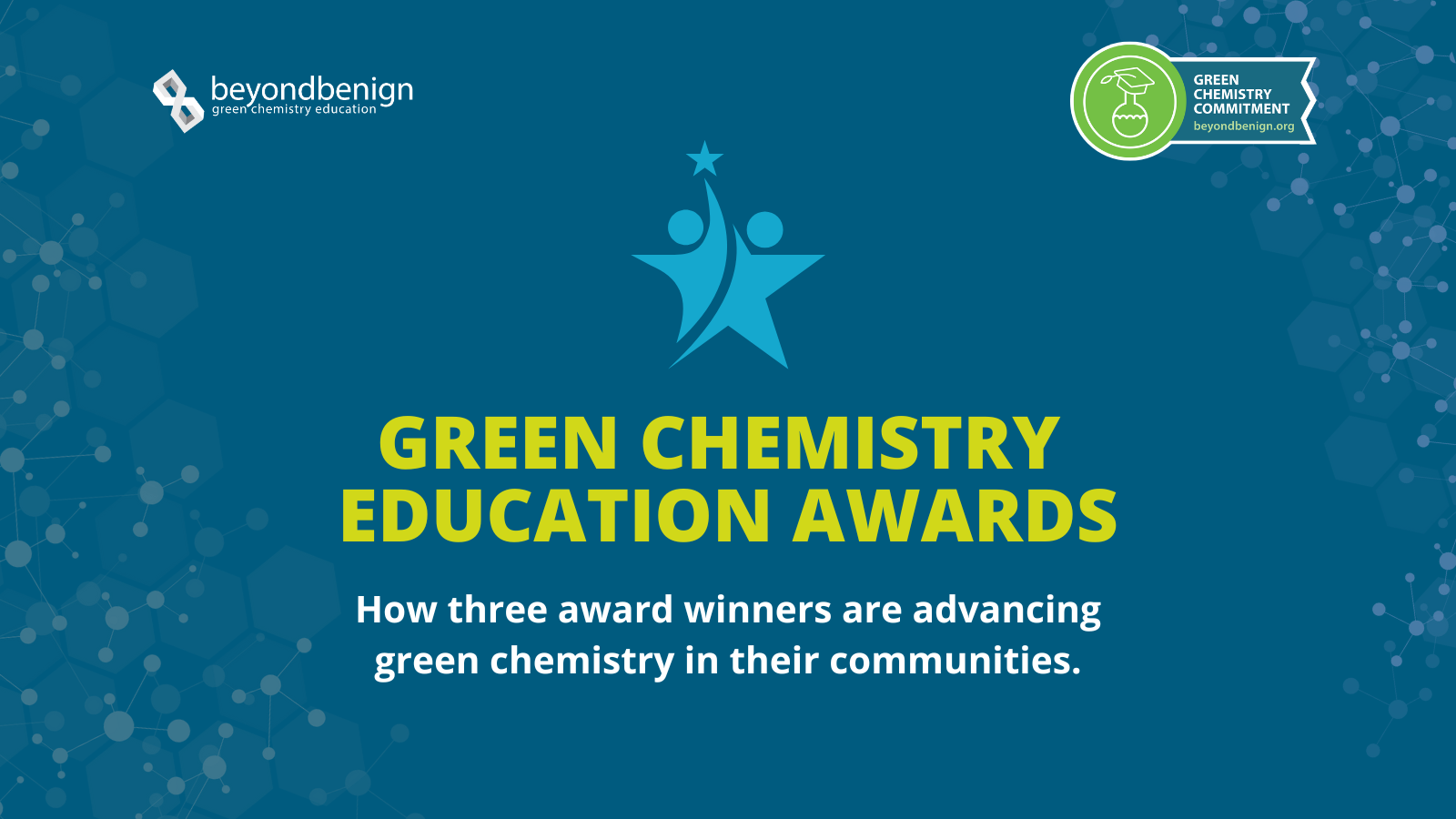
Empowering Future Scientists: Green Chemistry Education Awards Connect Students With Sustainability Skills
June 20, 2025
As the community of educators and institutions integrating green chemistry grows, more students are learning a sustainable approach to science. These students represent the next generation of innovators, environmental stewards, […]
Categories:
How California State University San Marcos Is Taking Steps Toward a Green Chemistry Minor
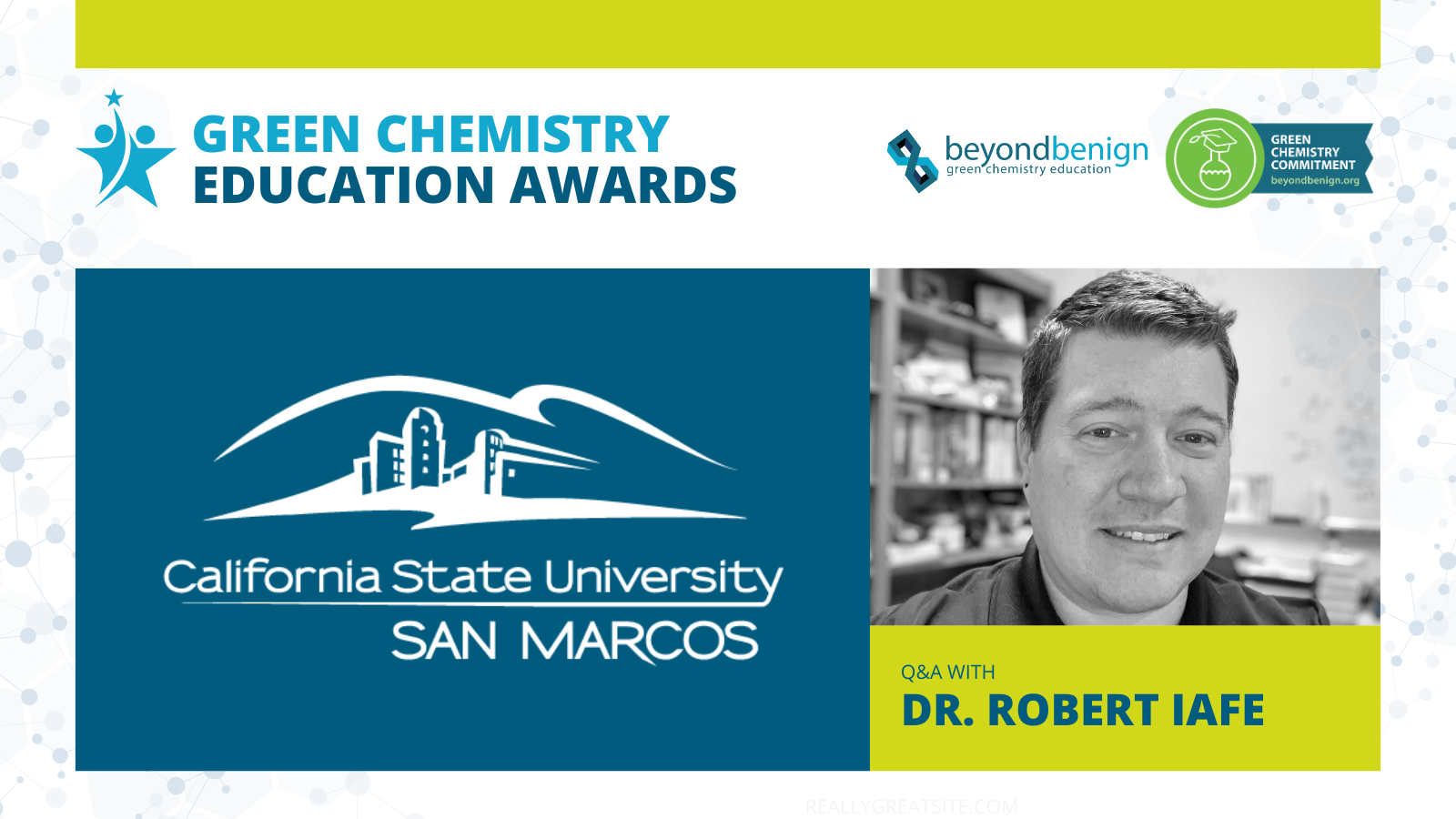 When educators are equipped to teach green chemistry, they don’t just change lessons—they shape the next generation of scientists, innovators, and environmental stewards. Through the Green Chemistry Education Awards, Beyond Benign provides funding to faculty and institutions around the world to embed sustainability into chemistry education. These awards help educators redesign labs, reimagine curricula, and create powerful, real-world connections for students. Among the 2023–2024 recipients were several Minority-Serving Institutions (MSIs), whose funded projects are expanding access to green chemistry in diverse learning environments.
When educators are equipped to teach green chemistry, they don’t just change lessons—they shape the next generation of scientists, innovators, and environmental stewards. Through the Green Chemistry Education Awards, Beyond Benign provides funding to faculty and institutions around the world to embed sustainability into chemistry education. These awards help educators redesign labs, reimagine curricula, and create powerful, real-world connections for students. Among the 2023–2024 recipients were several Minority-Serving Institutions (MSIs), whose funded projects are expanding access to green chemistry in diverse learning environments.
Award recipient Dr. Robert G. Iafe, Associate Professor at California State University San Marcos, says the green chemistry initiative has helped students develop a new sense of purpose and enthusiasm. “While we expected the green chemistry courses to be academically engaging, we didn’t fully anticipate how deeply students would connect with the broader themes of sustainability and social responsibility,” he says. “Many of our students come from communities that are disproportionately impacted by environmental issues, so when they see chemistry as a means of creating safer materials, cleaner technologies, and more equitable systems, it becomes more than just a course—it becomes personally meaningful and empowering.
In the Q&A below, Robert discusses progress on the university’s efforts to develop a green chemistry minor, highlights from a recent green chemistry event on campus, and other reflections.
Can you provide a brief overview of your project, including the key objectives you aimed to achieve with the funding and any significant outcomes or milestones you have reached so far?
Our project is focused on establishing a Green Chemistry minor within the Department of Chemistry and Biochemistry at California State University San Marcos (CSUSM). The initiative is built around three core objectives. First, we’re developing Green Chemistry and Toxicology courses that are thoughtfully designed to meet the needs of our diverse student body, particularly as an MSI with a large population of first-generation Hispanic students. Second, we’re implementing both qualitative and quantitative assessment strategies to better understand how these courses influence student success, persistence, and self-efficacy. And third, we’re working to increase campus and community engagement by hosting public seminars that feature leaders in the field of green chemistry. These events aim to raise awareness about sustainable chemistry and introduce students to related career pathways.
We’ve already made substantial progress. We’ve piloted the initial versions of both the Green Chemistry and Toxicology courses and submitted them for formal inclusion in the undergraduate curriculum. In parallel, we’ve submitted a proposal for the Green Chemistry minor itself, which is currently making its way through the university’s curriculum approval process.
One of the highlights so far has been the Green Chemistry Symposium we hosted on March 21, 2025. It was an exciting milestone for us. We welcomed guest speakers from Thermo Fisher Scientific and Beyond Benign, who shared insights on green chemistry technologies and professional pathways with an audience of over 130 undergraduate and graduate students. The event also included a pedagogy workshop that brought together faculty from CSUSM as well as neighboring institutions like SDSU and USD. Events like this really help build momentum—not just around curriculum development, but around a broader culture of sustainability and innovation on campus.
Can you describe the process of developing the Green Chemistry minor and how student feedback has shaped its content? Approximately how many students do you anticipate the Green Chemistry minor and its related courses will reach each year?
The development of the Green Chemistry minor at CSUSM has truly been a collaborative and evolving effort. From the beginning, we prioritized both pedagogical integrity and student input. We started by piloting Green Chemistry and Toxicology courses using open-access resources from Beyond Benign, offering them initially as special topics courses. This allowed us to gather real-time feedback through course evaluations and student surveys. Faculty have been actively incorporating this feedback to improve course content, structure, and learning outcomes, especially to ensure the material resonates with our students, many of whom are first-generation college students and come from historically underrepresented backgrounds. Our goal has been to build a program that’s not only academically rigorous but also personally meaningful and accessible.
Looking ahead, we anticipate that the Green Chemistry minor and its associated courses will engage approximately 40 students per year within five years of launch. Each course is expected to enroll around 20 students per semester, and we also foresee interest from students in related STEM disciplines like biology, biotechnology, kinesiology, and environmental science. Importantly, because green chemistry learning outcomes are being integrated across our broader curriculum, all Chemistry majors—not just those enrolled in the minor—will benefit from exposure to sustainable chemistry principles. We’re really excited about the broader impact this initiative will have across our department and the university.
Our goal is to help students see themselves not just as future scientists, but as changemakers—individuals who can apply their knowledge to drive meaningful, sustainable solutions within their communities and beyond.
How do you see this project preparing students to be leaders in the sustainable workforce of the future? Have you seen any signs of students beginning to envision their role in sustainability-focused careers?
This project was intentionally designed to equip our students with the skills and mindset needed to become leaders in the sustainable workforce. By embedding green chemistry principles throughout the undergraduate curriculum and offering hands-on, experiential learning opportunities, we’re helping students make real-world connections to sustainability. Through specialized courses in Green Chemistry and Toxicology, students are gaining a solid foundation in designing safer chemicals, minimizing environmental impact, and applying sustainability concepts to chemical processes—skills that are increasingly valued in sectors ranging from industry and government to academia.
Equally important, we’ve integrated culturally responsive pedagogy to ensure the curriculum feels relevant and empowering for our diverse student population. Our goal is to help students see themselves not just as future scientists, but as changemakers—individuals who can apply their knowledge to drive meaningful, sustainable solutions within their communities and beyond.
We’re already seeing promising signs of impact. Beyond the strong turnout and enthusiasm at the Green Chemistry Symposium, we’ve noticed growing student interest in green chemistry-related research and activities. Students have begun inquiring about research opportunities in this area, and there has even been discussion about forming a student-led green advisory board, potentially in partnership with our American Chemical Society Student Chapter. We fully expect that as this momentum builds, we’ll see an increase in student participation in sustainability-focused internships and programs, including NSF-REUs and industry collaborations. It’s exciting to watch students start envisioning their roles in a more sustainable future.
How do you plan to measure the success of the new courses and the overall effectiveness of the Green Chemistry minor in retaining students in chemistry research?
We will assess the overall effectiveness of the Green Chemistry minor through a multi-faceted evaluation strategy that includes both qualitative and quantitative metrics. First, we will utilize student pre- and post-course surveys to gather feedback on student learning experiences, engagement, and perceived relevance of course content. This will help ensure that the curriculum is meeting the needs of our diverse student population and supporting their academic development.
Second, in collaboration with the Office of Institutional Planning and Analysis (IPA), we will conduct longitudinal data tracking to monitor key indicators of student success, including course performance, retention within the chemistry major, persistence in STEM pathways, and graduation rates. We will specifically analyze outcomes for students enrolled in the Green Chemistry courses and minor, with disaggregated data by demographic groups to assess equity in impact.
Third, we will collect data on student involvement in research, internships, and co-curricular opportunities related to sustainability and green chemistry. We anticipate that the integration of green chemistry content will increase student interest in pursuing independent research, summer programs, and career pathways aligned with sustainability.
And finally, the number of students declaring the Green Chemistry minor and continued enrollment trends will serve as key indicators of institutional impact. These metrics, along with follow-up surveys post-graduation, will help us evaluate the program’s success in preparing students for sustainability-focused careers and retaining them in chemistry research.
What are your hopes for the future of the Green Chemistry program at CSUSM and its potential impact on students and the wider community?
Our long-term vision for the Green Chemistry program is to establish it as a leading model for inclusive, sustainability-focused STEM education in the region. We see CSUSM becoming a regional hub for green chemistry education, particularly among MSIs, by offering a curriculum that goes beyond technical training to also foster environmental responsibility and social consciousness in the next generation of scientists.
Looking ahead, we hope to expand the program’s impact by integrating green chemistry principles throughout the broader chemistry curriculum, encouraging interdisciplinary collaboration, and building strong partnerships with local industries, environmental organizations, and K-12 schools. The Green Chemistry minor is designed not just as a set of courses, but as a launchpad—supporting students as they pursue research, graduate education, and careers in areas like renewable energy, sustainable manufacturing, public health, and environmental policy.
For our students, we believe that early, meaningful exposure to real-world applications of green chemistry—combined with opportunities to connect with professionals in the field—will build both their confidence and their sense of purpose. It’s about helping them see themselves in sustainability-focused careers and supporting their long-term academic and professional success.
Beyond the campus, we’re also focused on community impact. Events like our Green Chemistry Symposium are just one example of how we hope to elevate environmental awareness and sustainability literacy across the region. Ultimately, our goal is to create a ripple effect, preparing graduates who are not only well-trained scientists but also empowered to lead positive change in their communities and within the global chemical industry.
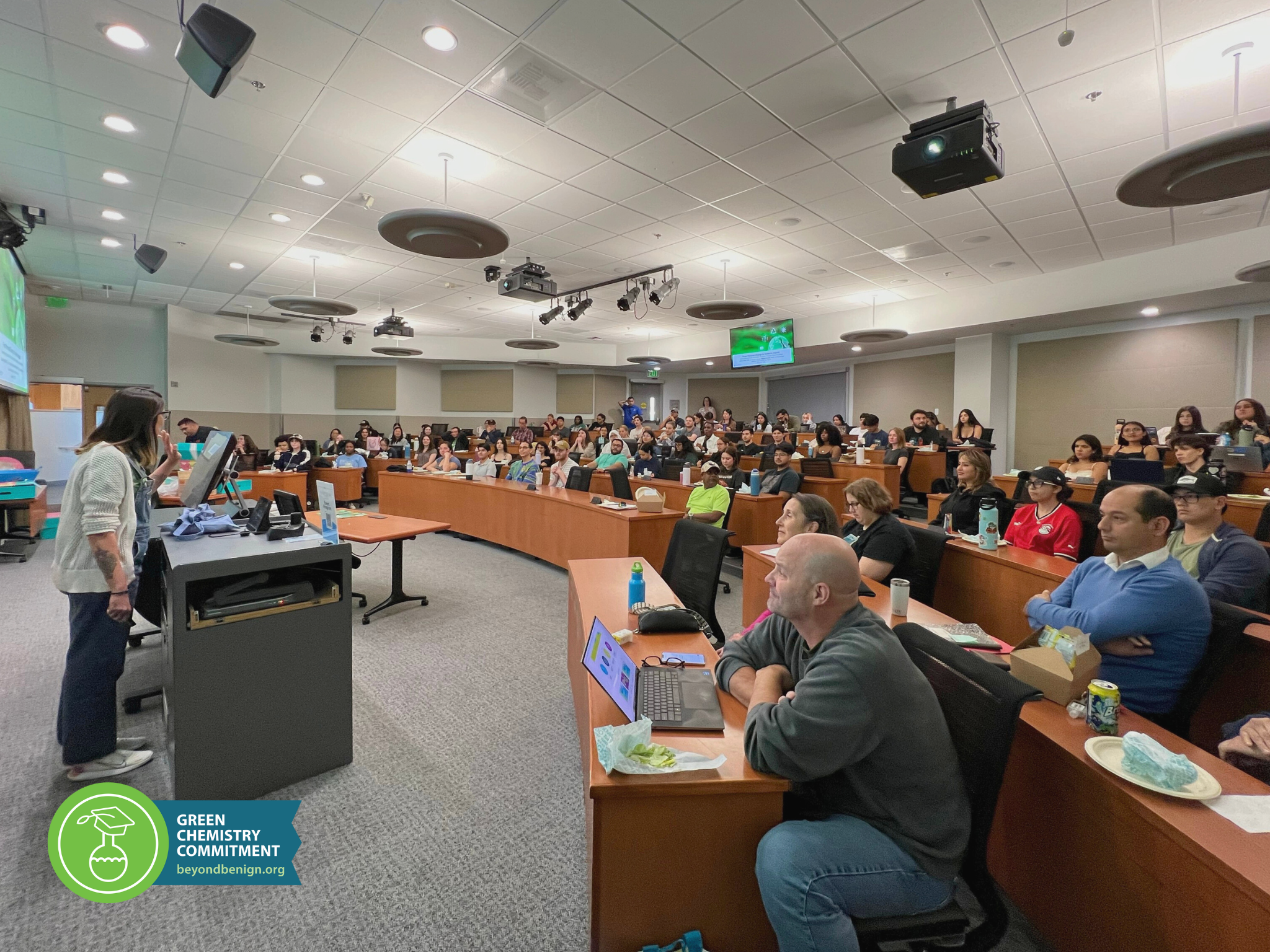
More than 200 students gathered at CSUSM in March 2025 for a green chemistry outreach event organized by the university’s Chemistry and Biochemistry Department. This gathering exemplifies CSUSM’s ongoing efforts to integrate green chemistry into student research, lab instruction, and community outreach.
Your university-wide green chemistry seminar featured speakers from ThermoFisher and Beyond Benign and drew strong attendance. What was the intended goal of the event, and what kind of impact did it have on students and the broader campus community?
The primary goal of the university-wide Green Chemistry Seminar was to elevate awareness of green chemistry principles and their real-world applications, while also inspiring students to consider sustainability-focused career paths. By featuring speakers from Thermo Fisher Scientific and Beyond Benign—leaders in both industry and education—we aimed to bridge the gap between classroom learning and professional practice. These speakers not only introduced cutting-edge technologies and sustainability initiatives but also shared their personal career journeys, offering students valuable insight into pathways they may not have previously considered.
The impact was immediate and energizing. With over 130 students, faculty, and community members in attendance, the event sparked meaningful conversations around the role of chemistry in building a more sustainable future. Students left the seminar asking thoughtful questions about internships, research opportunities, and how they might apply green chemistry in their own academic work. Additionally, the event included a pedagogy workshop attended by faculty from CSUSM and neighboring institutions, which helped foster collaboration and expand the reach of green chemistry education beyond our campus. Overall, the seminar not only reinforced the importance of sustainability within the sciences but also helped establish CSUSM’s identity as a major contributor in green chemistry education across the region.
Why was this funding critical to the success of your project? Were there barriers you were facing that this support helped you overcome—either for you, your students, or your institution?
This funding played a pivotal role in the success of our project. As a primarily undergraduate, teaching-focused institution, CSUSM can face structural and financial challenges when it comes to launching new academic initiatives—especially those that demand significant faculty time for curriculum development, student assessment, and community outreach. The support from this award helped us overcome several of those key challenges. It allowed us to thoughtfully develop and adapt Green Chemistry and Toxicology courses using Beyond Benign’s open-access resources, while tailoring the content to resonate with our diverse student body. It also gave us the capacity to implement robust assessment strategies, both qualitative and quantitative, that simply would not have been feasible without this dedicated funding.
Perhaps just as importantly, the award made it possible for us to host our first Green Chemistry Symposium by providing funding for guest speakers—something that many Primarily Undergraduate Institutions typically cannot support due to limited resources for honoraria and travel. Bringing in nationally recognized leaders from Thermo Fisher Scientific and Beyond Benign created a unique and impactful experience for our students and faculty, fostering excitement and deeper engagement with sustainability-focused careers and research. Ultimately, this funding removed critical financial and logistical barriers and enabled us to bring our vision for green chemistry at CSUSM to life in a way that is both inclusive and forward-looking.
How to get involved:
- Explore how award recipients are bringing green chemistry to life at Stella and Charles Guttman Community College and Pontifical Catholic University.
- Subscribe to Beyond Benign’s newsletter for the latest updates from the green chemistry community and to be the first to know when Green Chemistry Education Awards are open.
- Not yet part of the Green Chemistry Commitment (GCC)? Learn how your institution can become a signer and provide students with essential skills and training for today’s workforce.

How California State University San Marcos Is Taking Steps Toward a Green Chemistry Minor
June 20, 2025
When educators are equipped to teach green chemistry, they don’t just change lessons—they shape the next generation of scientists, innovators, and environmental stewards. Through the Green Chemistry Education Awards, Beyond […]
Categories:
How Green Chemistry at Pontifical Catholic University Is Planting the Seeds for a More Sustainable Future
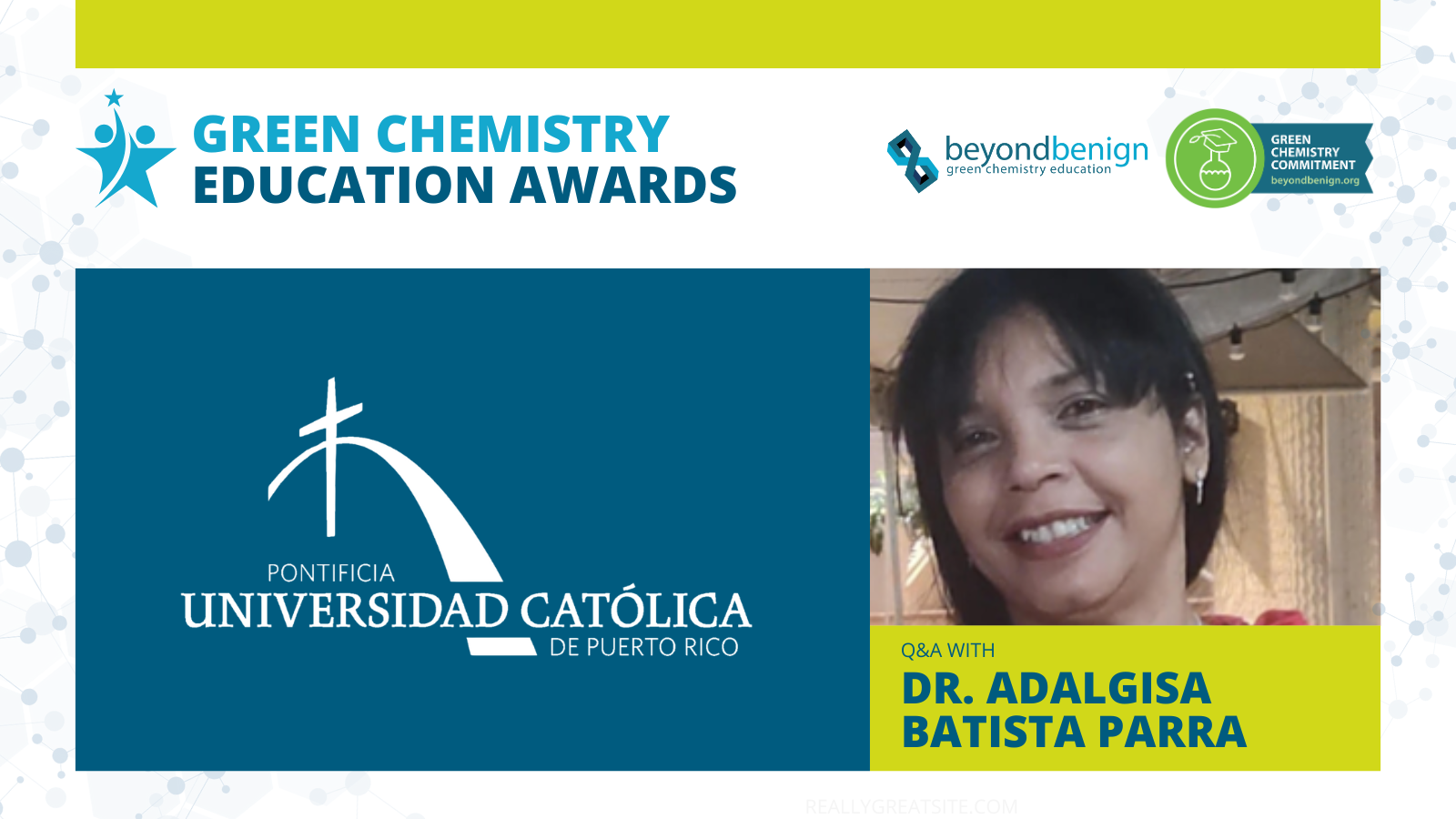 When educators are equipped to teach green chemistry, they don’t just change lessons—they shape the next generation of scientists, innovators, and environmental stewards. Through the Green Chemistry Education Awards, Beyond Benign provides funding to faculty and institutions around the world to embed sustainability into chemistry education. These awards help educators redesign labs, reimagine curricula, and create powerful, real-world connections for students. Among the 2023–2024 recipients were several Minority-Serving Institutions (MSIs), whose funded projects are expanding access to green chemistry in diverse learning environments.
When educators are equipped to teach green chemistry, they don’t just change lessons—they shape the next generation of scientists, innovators, and environmental stewards. Through the Green Chemistry Education Awards, Beyond Benign provides funding to faculty and institutions around the world to embed sustainability into chemistry education. These awards help educators redesign labs, reimagine curricula, and create powerful, real-world connections for students. Among the 2023–2024 recipients were several Minority-Serving Institutions (MSIs), whose funded projects are expanding access to green chemistry in diverse learning environments.
Award recipient Dr. Adalgisa Batista Parra, Professor of Chemistry and Organic Chemistry Researcher at Pontifical Catholic University of Puerto Rico, says green chemistry sparked meaningful discussions among students about their role in shaping a more sustainable future. “What began as a curriculum redesign became an opportunity to reflect on our values, our impact, and the kind of legacy we want to leave for our students,” she says. “This project is about more than just redesigning lab experiments—it’s about planting the seeds of a cultural shift toward sustainability in science education and beyond.”
In the Q&A below, Adalgisa shares more about her green chemistry efforts and how they have influenced her instruction, her students, and her university colleagues.
What began as a curriculum redesign became an opportunity to reflect on our values, our impact, and the kind of legacy we want to leave for our students. This project is about more than just redesigning lab experiments—it’s about planting the seeds of a cultural shift toward sustainability in science education and beyond.
Can you provide a brief overview of your project, including the key objectives you aimed to achieve with the funding and any significant outcomes or milestones you have reached so far?
Our project centers on redesigning the undergraduate organic chemistry laboratory curriculum to incorporate green chemistry principles with the goal of aligning instruction with emerging trends in sustainable chemistry education while actively reducing environmental impact.
With the support of funding, our primary objectives are to:
- implement greener synthesis routes to promote sustainability,
- adopt safer solvents to minimize health and environmental risks, and
- reduce chemical waste through optimized experimental procedures.
These changes were piloted with a select group of students to evaluate effectiveness and feasibility. Currently, the changes are being implemented in the organic chemistry laboratory curriculum.
Significant milestones achieved to date include:
- The completion of a pilot redesign for several laboratory experiments using safer solvents and greener synthetic techniques.
- The collection of baseline data on waste output and solvent usage, which will inform future impact assessments.
- The development of new student learning outcomes emphasizing sustainability, green chemistry practices, and responsible chemical handling.
What motivated the redesign of the organic chemistry laboratory curriculum to incorporate green chemistry principles, and how does it differ from the previous curriculum?
The primary motivation for redesigning the organic chemistry laboratory curriculum was the growing need to align educational practices with the principles of green and sustainable chemistry. Traditional laboratory experiments often rely on hazardous solvents, generate significant chemical waste, and lack emphasis on environmental responsibility. As chemistry evolves to address global environmental challenges, it is essential that our teaching laboratories reflect these priorities and prepare students for a future where sustainability is integral to scientific practice. Additional motivators included:
- Limited student exposure to environmentally responsible techniques and real-world applications of green chemistry.
- A desire to reduce the environmental footprint of the teaching laboratory and model more sustainable behavior within the academic setting.
The redesigned organic chemistry laboratory curriculum differs significantly from the previous version by shifting the focus toward sustainability, safety, and real-world relevance. Whereas the traditional curriculum relied heavily on hazardous solvents and reagents, the updated version introduces greener, safer alternatives that reduce health and environmental risks. The new approach emphasizes sustainability metrics, such as atom economy and waste reduction, alongside reaction success. Students now engage in experiments that are optimized not only for chemical outcomes but also for minimizing waste and maximizing efficiency.
What feedback have you received from students participating in the pilot testing of greener synthetic routes, and how has this influenced the curriculum?
Feedback from students participating in the pilot testing of greener synthetic routes has been overwhelmingly positive and insightful. Many students expressed appreciation for working with safer, less toxic materials, noting that it made the lab environment feel more secure and modern. Several also shared that learning about the environmental impact of chemical processes made the course more meaningful and relevant to current global challenges.
As a result of this feedback, the curriculum will be refined to include more structured opportunities for students to analyze the environmental impact of each experiment. We will also develop supporting materials to better explain green chemistry principles and ensure students can connect theory with practice.
How do you see this project preparing students to be leaders in the sustainable workforce of the future? Have you seen any signs of students beginning to envision their role in sustainability-focused careers?
This project is equipping students with the mindset and skills needed to become leaders in a sustainability-focused workforce. By integrating green chemistry principles into their lab experiences, students are learning to prioritize environmental responsibility alongside scientific rigor. They are not just memorizing reactions—they’re critically evaluating the impact of their work, exploring alternatives, and thinking innovatively about how chemistry can contribute to a more sustainable world.
We’ve already seen encouraging signs that students are beginning to envision themselves in sustainability-driven roles. Some have expressed interest in pursuing careers in environmental science or regulatory policy. Others have mentioned how this experience reshaped their understanding of chemistry’s role in solving real-world problems, inspiring them to look for research or industry opportunities aligned with sustainability.
Overall, the project is doing more than teaching chemistry—it’s helping to shape responsible, forward-thinking scientists who understand that sustainable practices are not just an option, but a necessity for the future of science and society.
Can you share any early data or insights related to waste reduction, solvent use, or other environmental benefits of the greener procedures? How do these results reinforce the value of integrating green chemistry into undergraduate labs?
Preliminary data from the pilot implementation of greener synthetic procedures shows promising environmental benefits. For example, in one redesigned experiment, we replaced toluene with water, a significantly safer solvent. In another case, the total mass of chemical waste generated per student was cut by more than 95% compared to the traditional version of the same experiment. These early results reinforce the value of integrating green chemistry into undergraduate labs by demonstrating that sustainability and scientific integrity can go hand-in-hand. Students still meet learning objectives and achieve strong outcomes, but in a way that aligns with modern environmental standards. Moreover, the measurable reductions in hazardous waste and solvent use highlight how small curricular changes can have a meaningful cumulative impact when scaled across multiple lab sections and semesters.
How do you plan to share the comprehensive report with university stakeholders, and what impact do you hope it will have on broader university practices?
We plan to share the comprehensive report through a combination of formal and informal channels. This includes presenting key findings at departmental meetings, curriculum committee sessions, and university-wide faculty development workshops. A digital version of the report will be made available through the university’s internal repository and shared directly with administrators and faculty. A snapshot of this work will be presented during the in-person 2025 Green Chemistry Commitment Summit on June 22nd in Pittsburgh, Pennsylvania.
The goal is not only to showcase the pilot’s success but also to initiate broader conversations about integrating sustainability across science education. We hope the report will inspire other departments to adopt similar practices, encourage investment in sustainable lab infrastructure, and strengthen the university’s overall commitment to environmental responsibility. Ultimately, we envision this project serving as a model for curriculum innovation, reinforcing the university’s leadership in both academic excellence and sustainable practices.
By integrating green chemistry into our program’s curriculum, we aim to model how environmental responsibility can be embedded into academic practices without compromising educational quality.
How do you hope this project shifts the culture around sustainability—not just in your department, but across the university? Have you seen early signs of that shift already?
By integrating green chemistry into our program’s curriculum, we aim to model how environmental responsibility can be embedded into academic practices without compromising educational quality.
We hope this initiative encourages other programs to evaluate their own practices through a sustainability lens—whether in teaching, research, procurement, or waste management. Our vision is to help foster a university-wide mindset where sustainability is not seen as an add-on, but as a core value guiding decisions and innovation across disciplines.
We’ve already seen early signs of this shift. Faculty from other science programs have expressed interest in our green chemistry strategies. Additionally, students are exploring how to apply green principles in other academic settings and how they can apply green principles in other courses and research projects, showing that the impact is already expanding beyond the lab.
In the long term, we hope this project contributes to a broader institutional culture that prioritizes environmental stewardship, interdisciplinary collaboration, and the preparation of students to be leaders in a sustainable future.
Why was this funding critical to the success of your project? Were there barriers you were facing that this support helped you overcome—either for you, your students, or your institution?
This funding was essential to the success of our project, enabling us to overcome key barriers that had previously limited our ability to modernize the organic chemistry lab curriculum. Prior to this support, we faced significant resource constraints—from the cost of safer, greener reagents and solvents, to the need for updated lab equipment and training materials.
The grant allowed us to pilot greener experiments without compromising instructional quality, and to collect baseline data on environmental impact—something we hadn’t had the capacity to do before. It also supported faculty development, helping instructors gain the knowledge and confidence needed to implement and teach green chemistry principles effectively.
For our students, the funding made it possible to gain hands-on experience with modern, sustainable lab techniques—an opportunity they wouldn’t have had under the traditional curriculum. More broadly, it gave our institution a model for what a sustainable lab redesign can look like, helping us take the first step toward long-term, campus-wide transformation.
Is there anything else you’d like to share about your experience with this grant—something unexpected, personally meaningful, or something you learned along the way?
It was incredibly rewarding to see students not only adapt to the new experiments but also ask more thoughtful questions, show greater environmental awareness, and express genuine excitement about being part of a positive change. It reminded us that when given the tools and the context, students rise to the occasion—they want to do work that matters.
Along the way, we also learned that change is possible, even in well-established systems, when you have the right support, clear goals, and a shared sense of purpose. This grant didn’t just fund a project—it empowered a shift in mindset that we hope will continue to grow across our department and beyond.
How to get involved:
- Explore how award recipients are bringing green chemistry to life at Stella and Charles Guttman Community College and California State University, San Marcos.
- Subscribe to Beyond Benign’s newsletter for the latest updates from the green chemistry community and to be the first to know when Green Chemistry Education Awards are open.
- Not yet part of the Green Chemistry Commitment (GCC)? Learn how your institution can become a signer and provide students with essential skills and training for today’s workforce.
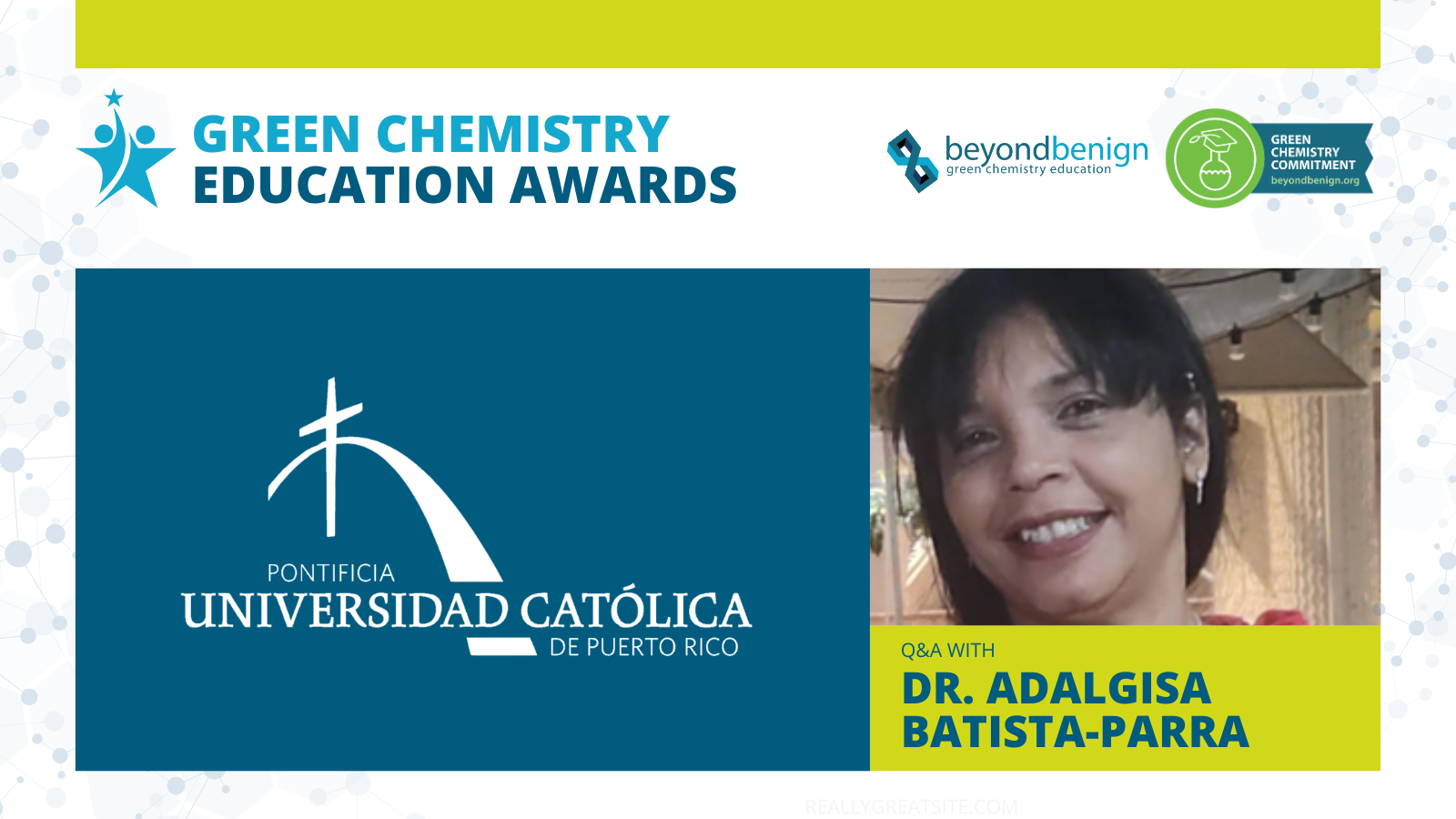
How Green Chemistry at Pontifical Catholic University Is Planting the Seeds for a More Sustainable Future
June 20, 2025
When educators are equipped to teach green chemistry, they don’t just change lessons—they shape the next generation of scientists, innovators, and environmental stewards. Through the Green Chemistry Education Awards, Beyond […]
Categories:
How Green Chemistry at Stella and Charles Guttman Community College Is Nurturing Innovation and a Sustainability-Minded Workforce
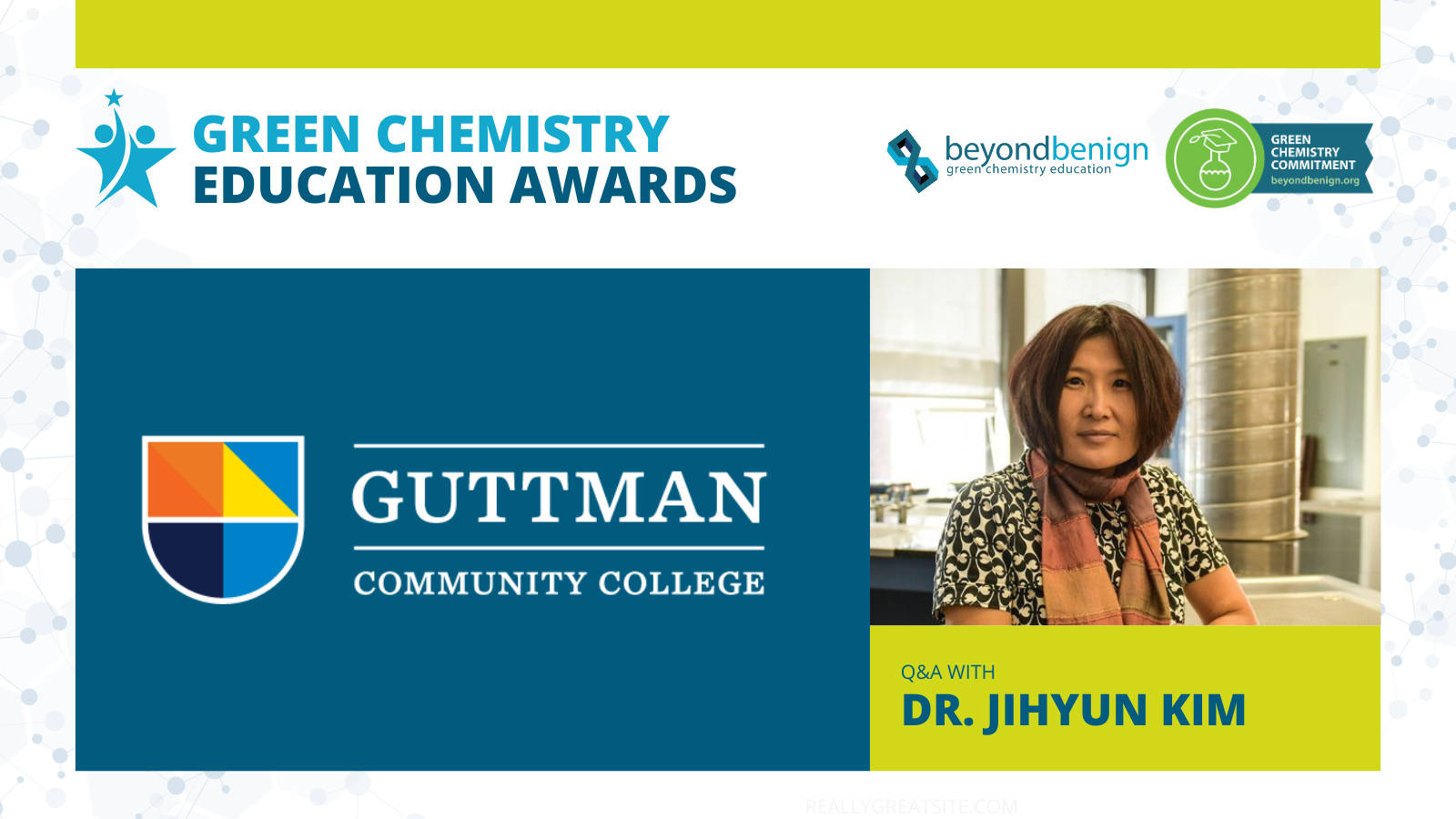
When educators are equipped to teach green chemistry, they don’t just change lessons—they shape the next generation of scientists, innovators, and environmental stewards. Through the Green Chemistry Education Awards, Beyond Benign provides funding to faculty and institutions around the world to embed sustainability into chemistry education. These awards help educators redesign labs, reimagine curricula, and create powerful, real-world connections for students. Among the 2023–2024 recipients were several Minority-Serving Institutions (MSIs), whose funded projects are expanding access to green chemistry in diverse learning environments.
Award recipient Dr. Jihyun (Ji) Kim, Associate Professor of Chemistry at Stella and Charles Guttman Community College, says the green chemistry concepts helped students see how chemistry can be a tool for environmental responsibility. “One of the most encouraging outcomes of this project was the level of student engagement with green chemistry concepts, particularly as they connected sustainability to real-world issues,” Ji says. “One student reflected on how using dried orange peels as a catalyst opened their eyes to the value of reusing food waste and sparked curiosity about other potential applications of natural materials in chemistry.”
In the Q&A below, Ji discusses how green chemistry education has helped students deepen their critical thinking skills and consider sustainability-focused career opportunities.
Can you provide a brief overview of your project, including the key objectives you aimed to achieve with the funding and any significant outcomes or milestones you have reached so far?
This project focused on redesigning a classic organic chemistry experiment—the synthesis of cyclohexene—to emphasize green chemistry principles and provide a safer, more sustainable laboratory experience for students at a resource-limited two-year college.
With support from the funding, the key objectives were to:
- reduce chemical waste and hazards using microscale techniques,
- introduce students to environmentally friendly alternatives to traditional reagents, and
- align experimental design with the 12 Principles of Green Chemistry.
Students explored alternative catalysts such as Amberlyst-15 and dried orange peels in place of conventional acids like phosphoric acid. The activity incorporated pre-laboratory research, group collaboration, and critical evaluation of chemical choices. Outcomes included increased student awareness of sustainability in chemistry, hands-on experience with safer materials, and thoughtful reflection on the environmental and health impacts of chemical practices. The use of microscale kits reduced waste and exposure risks, while also addressing institutional limitations like limited fume hood access.
Overall, the project served as a successful model for incorporating green chemistry into the undergraduate laboratory curriculum and highlighted opportunities for further research in sustainable lab practices.

Beyond Benign Co-Founder and Executive Director, Dr. Amy Cannon, visited Guttman Community College in September 2024. Here, Amy is pictured in the lab with Ji, students, and the microscale glassware kits.
What impact have the microscale glassware kits had on student learning or engagement in the lab? How have students responded to this shift in hands-on experience?
The introduction of microscale glassware kits had a notable positive impact on student learning and engagement in the laboratory. Survey results indicated that most students felt confident using the microscale setup, with approximately 88% expressing comfort with performing microscale experiments. The kits allowed students to carry out organic synthesis using significantly reduced quantities of chemicals, aligning with green chemistry principles while minimizing safety risks and waste production.
Qualitative feedback from student reflections also highlighted the appeal of the hands-on experience. Students appreciated the accessibility and manageability of the equipment, especially in a setting with limited fume hood access. While a small percentage (12%) reported some discomfort or challenges—suggesting the need for additional scaffolding or practice—the overall response was positive.
The microscale kits enabled students to focus more on experimental design, sustainability, and chemical safety, making the lab experience more meaningful and aligned with real-world applications of green chemistry.
What methods are you using to assess student understanding of the 12 Principles of Green Chemistry, and what have you found effective?
Student understanding of the 12 Principles of Green Chemistry was assessed through a combination of pre-laboratory activities, collaborative discussions, lab reports, and post-activity reflections. During a dedicated pre-lab session, students reviewed the principles and discussed how they related to the planned experiment. Each group was tasked with aligning their chosen modifications—such as the use of Amberlyst-15 or dried orange peels—with specific principles, fostering intentional connections between theory and practice.
As part of their lab reports, students were required to identify and justify which green chemistry principles their experimental design addressed. The class collectively concluded that their approaches satisfied at least six of the 12 principles, demonstrating a strong grasp of the framework and its practical applications.
What challenges have you encountered during the implementation of new experimental procedures, and how have you addressed them?
Several challenges emerged during the implementation of the redesigned experimental procedures. One primary challenge was the use of microscale glassware kits, which, while aligned with green chemistry goals, required students to adapt to working with smaller quantities and more precise techniques. Some students initially struggled with unfamiliar equipment and the level of care needed for accurate handling. To address this, additional guidance was provided during the pre-lab sessions, and the instructor demonstrated proper technique to build student confidence.
Another challenge involved managing expectations around reaction yields. Because the focus of the activity was on sustainability rather than maximizing product yield, students needed support in understanding the trade-offs between greener methods and traditional efficiency. This was addressed through guided discussions and reflection prompts that emphasized process over outcome.
This project empowers students to think critically about sustainability in chemical practice, fostering awareness of eco-conscious decision-making.
How do you see this project preparing students to be leaders in the sustainable workforce of the future? Have you seen any signs of students beginning to envision their role in sustainability-focused careers?
This project empowers students to think critically about sustainability in chemical practice, fostering awareness of eco-conscious decision-making.
Through hands-on experience with green chemistry, many began envisioning their role in solving environmental challenges. Some even expressed interest in sustainability-focused careers, signaling early leadership potential in the green workforce.
Why was this funding critical to the success of your project? Were there barriers you were facing that this support helped you overcome—either for you, your students, or your institution?
This funding was critical in enabling the implementation of a redesigned, sustainability-focused lab activity at a resource-limited two-year college. With limited access to fume hoods and traditional lab infrastructure, the support allowed us to purchase microscale kits and eco-friendly reagents that aligned with green chemistry principles. It also supported curriculum development time to create engaging, accessible materials tailored to our diverse student population. Without this funding, hands-on experience with safer, more sustainable methods would not have been feasible. It helped overcome institutional barriers, expanded learning opportunities for students, and laid the groundwork for integrating sustainability into our STEM curriculum.
Is there anything else you’d like to share about your experience with this grant—something unexpected, personally meaningful, or something you learned along the way?
This grant reaffirmed the power of innovation in resource-limited settings. An unexpected outcome was how deeply students connected with sustainability when given ownership of their learning. Watching them think critically, collaborate, and make environmentally conscious choices was incredibly meaningful—and reminded me why inclusive, hands-on science education truly matters.
How to get involved:
- Read Ji’s article Integrating Artificial Intelligence (AI) Chatbots and Green Chemistry Principles in the Synthesis of Cyclohexene.
- Explore how award recipients are bringing green chemistry to life at Pontifical Catholic University and California State University, San Marcos.
- Subscribe to Beyond Benign’s newsletter for the latest updates from the green chemistry community and to be the first to know when Green Chemistry Education Awards are open.
- Not yet part of the Green Chemistry Commitment (GCC)? Learn how your institution can become a signer and provide students with essential skills and training for today’s workforce.

How Green Chemistry at Stella and Charles Guttman Community College Is Nurturing Innovation and a Sustainability-Minded Workforce
June 20, 2025
When educators are equipped to teach green chemistry, they don’t just change lessons—they shape the next generation of scientists, innovators, and environmental stewards. Through the Green Chemistry Education Awards, Beyond […]
Categories:
Practicing Safer Science: The Urgent Case for Green Chemistry Education
 In the webinar “Green Chemistry as the Foundation of Sustainability and the Circular Economy,” Dr. John Warner, a founder of Beyond Benign and the field of green chemistry, discusses how green chemistry can maximize sustainability when embedded into the early stages of research and development. To do so effectively, however, requires a specific set of critical skills. John is an award-winning industrial chemist with over 350 patents whose work has earned him honors including the Perkin Medal, the Presidential Award for Excellence in Science Mentoring, and the August Wilhelm von Hofmann Medal.
In the webinar “Green Chemistry as the Foundation of Sustainability and the Circular Economy,” Dr. John Warner, a founder of Beyond Benign and the field of green chemistry, discusses how green chemistry can maximize sustainability when embedded into the early stages of research and development. To do so effectively, however, requires a specific set of critical skills. John is an award-winning industrial chemist with over 350 patents whose work has earned him honors including the Perkin Medal, the Presidential Award for Excellence in Science Mentoring, and the August Wilhelm von Hofmann Medal.
Read highlights from John’s talk below, or watch the recording here. This conversation was hosted by Merck KGaA, Darmstadt, Germany.
When we consider the real-world health issues linked to the chemical compounds used in everyday products, it’s no surprise that many people associate chemistry with harm rather than good.
“You open up the newspaper, turn on the radio, look on the internet, all we hear about is, ‘This is bad, this is scary, this is dangerous,’” John says. “If people in our society are talking about chemistry, it’s usually not for a good reason, and this is a problem. I think that we own this as chemists, and we need to do a better job communicating the value of chemistry to society while also accepting that there are problems.”
John argues that it’s not enough for society to simply want sustainable technologies. Advocacy can only take us so far if the scientists, researchers, and workers who help power the world lack the necessary skill sets to drive critical change.
We know change is needed and that humanity is facing multiple crises connected to chemistry and its impact on the environment. We have discovered the problems. Now, we need to take action to enable solutions. This is the domain of green chemistry—and the foundation for Beyond Benign’s Green Chemistry Commitment (GCC).
The GCC is a framework to unite the higher education community around a common vision to expand the community of green chemists, grow departmental resources, improve connections to job opportunities, and affect systemic and lasting change in chemistry education. With green chemistry skills, chemists can work to anticipate the negative impacts of chemicals on human health and the environment. John says it’s not just a nice thing to do, it’s an ethical obligation.
“People in the general public, they’re not talking about our triumphs, they’re talking about our disasters, and we have a moral and ethical responsibility to do something about this,” John says. “But if students aren’t learning what makes something toxic, what makes something hurt the environment, how are they going to invent something that doesn’t?”
Knowledge is just the beginning; green chemistry needs to enter the mainstream. To do so, it has to work just as well as what’s out there—perhaps even better.
“What is most important is that green chemistry has to manifest in the real world,” John says. “This isn’t a journal article. This isn’t a webinar. Green chemistry must reduce hazards from our society. So of course, it has to be more environmentally benign, but it also has to work, and it has to have excellent performance because if it’s not as good as what people already can get, no one’s going to use it—and it has to have the right cost. It can’t be just wealthy people who can afford it. It has to be affordable for all.”
Some might say that’s a tall order. We already know that green chemistry works on a large scale because it’s happening in real time.
John points to several green chemistry success stories; among them are promising new ALS therapies, technology to restore degraded asphalt, and a device that keeps a battery charged using indoor ambient light.
Every year in the United States, roughly 20,000 chemists graduate each year (at all degree levels). These are big numbers, but few of these universities build their curriculum around human health or the environment. Thankfully, John says that the story is changing. From new guidelines released by the American Chemical Society (ACS) to the blossoming Green Chemistry Commitment headed by Beyond Benign and supported by corporate sponsors, seeds of change are being sown in academia.
“Imagine a student working in a lab doing chemistry research, and because they got it right, hundreds of thousands of people they will never meet are no longer exposed to a hazardous material—because they figured it out,” John says. “What could be more empowering? What could be more amazing?”
How to get involved:
- K-12 educators: Enroll in a professional development course to empower your students with safer, more sustainable science labs.
- Higher education leaders: Join the Green Chemistry Commitment to provide students with essential skills and training for today’s workforce.
- Connect with your peers in the Green Chemistry Teaching and Learning Community, an online space for everyone in the green chemistry community to learn, share, connect, and grow.
- Subscribe to Beyond Benign’s newsletter to get green chemistry news, opportunities, and resources delivered to your inbox monthly.

Practicing Safer Science: The Urgent Case for Green Chemistry Education
April 22, 2025
In the webinar “Green Chemistry as the Foundation of Sustainability and the Circular Economy,” Dr. John Warner, a founder of Beyond Benign and the field of green chemistry, discusses how […]
Categories:
Celebrating Edward J. Brush – Professor, Bridgewater State University (May 7, 1956 – February 23, 2025)

Pictured: Ed Brush on July 15, 2016
A colleague, friend, and passionate advocate for green chemistry, environmental justice, and sustainability.
“I alone cannot change the world, but I can cast a stone across the waters to create many ripples.” – Mother Teresa
Beloved community member and leader, Ed Brush, sadly passed away on February 23rd, 2025. You can read Ed’s obituary, share memories, and more at this link.
Beyond Benign is gathering memories and photos of Ed from the community to be shared in a memorial at the 2025 Green Chemistry Commitment Summit and ACS Green Chemistry & Engineering Conference. You can contribute to the memorial using this google form.
A Letter from Beyond Benign Co-Founders, Amy Cannon and John Warner
It is with deep sorrow that we share the passing of Ed Brush, a beloved member of the green chemistry education community and a long-time partner, colleague and friend to us at Beyond Benign. We also hold deep gratitude as we remember his life and work and the many, many ripples he created over the course of his life. While he will be dearly missed, his work and passion will be carried on and echoed throughout the green chemistry education community. Ed touched hundreds, if not thousands, of lives through his work as an educator and his unwavering commitment to advancing green chemistry education.
We first met Ed in the early 2000s when we were at the University of Massachusetts. As a faculty member at Bridgewater State University (BSU), Ed invited John to give a keynote talk at a new Undergraduate Research Symposium he was organizing. The research symposium reflected Ed’s passions: undergraduate student engagement and sustainability. The enthusiasm of the students was palpable, and it was energizing to see their posters; many aligned undergraduate chemistry research with the 12 principles of green chemistry, and others focused on important, relevant environmental challenges. From that day on, Ed was a valued part of our network and a key collaborator and colleague in our work in New England and beyond. He even spent a sabbatical working with us at the University of Massachusetts Lowell, where he focused on green chemistry research and worked closely with students in the Center for Green Chemistry.
Since founding Beyond Benign in 2007, we had the privilege of collaborating with Ed to create resources, run workshops for both higher education faculty and K-12 educators, and organize symposia. He was a member of our founding Advisory Board that created the Green Chemistry Commitment program, and his ideas and perspectives were essential in making it what it is today. BSU was part of the first cohort of 13 universities to sign on to the Commitment, and Ed was among the biggest supporters and advocates for engaging additional institutions. In 2019, Beyond Benign hosted 12 green chemistry educators for a focus group that ultimately seeded the creation of the Green Chemistry Teaching and Learning Community (GCTLC), another initiative Ed helped inspire.
Ed was also an active member of the American Chemical Society (ACS), a committee member for the Committee for Environmental Improvement (now the Committee on Environment and Sustainability), and he sought to include green chemistry in the chemical education programming at the ACS national meetings over the past 20 years. Thanks to his work, green chemistry and sustainability is now a regular part of the chemical education programming. He was passionate about the potential for chemistry to address sustainability challenges, creating unique activities that aligned chemistry to the U.N. Sustainable Development Goals and advocating for safer, better chemistry to address systemic issues in environmental and social justice.
Ed’s legacy is one of profound impact. Through his work, he helped to shape the future of green chemistry education, making it accessible and inspiring to so many. Beyond his professional contributions, Ed’s compassionate, kind, and gentle nature made him a pleasure to work alongside. He welcomed everyone into the community with open arms, and his generosity will never be forgotten. Working with him was truly a pleasure and a privilege.
While we will miss Ed dearly, we know that his work lives on — in so much of what we do at Beyond Benign and throughout the broader green chemistry education community. Ed created countless ripples across our community, and those ripples have grown into waves that continue to transform chemistry education.
Amy Cannon and John Warner, Co-Founders, Beyond Benign

Ed (left) with college faculty and Beyond Benign’s first cohort of Green Chemistry K-12 Lead Teachers (2016)

Beyond Benign headquarters for a Green Chemistry Education focus group (2019) with 11 additional university faculty

Ed presenting to a group of faculty during the Green Chemistry Commitment Summit (2019)

Ed (middle, right) with a group of green chemistry educators and Beyond Benign staff, Green Chemistry & Engineering Conference, 2024

Celebrating Edward J. Brush – Professor, Bridgewater State University (May 7, 1956 – February 23, 2025)
April 16, 2025
Pictured: Ed Brush on July 15, 2016 A colleague, friend, and passionate advocate for green chemistry, environmental justice, and sustainability. “I alone cannot change the world, but I can cast […]
Categories:
- « Previous Page
- 1
- 2
- 3
- 4
- …
- 19
- Next Page »
